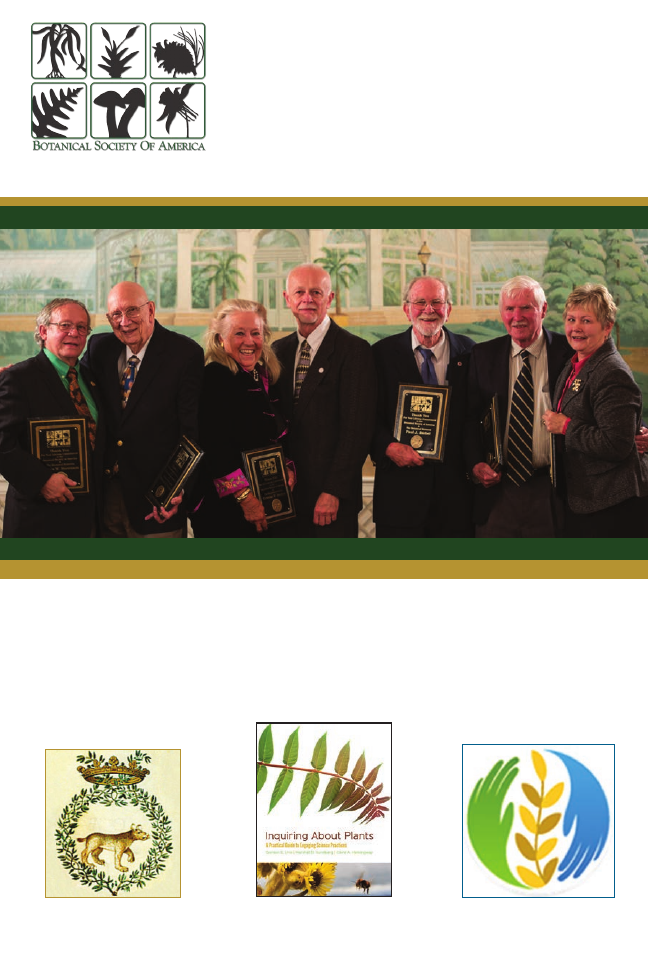
P
LANT
S
CIENCE
Bulletin
Winter 2013 Volume 59 Number 4
In This Issue..............
Learned Societies - Past, Present &
Future.....p. 150
BSA announces new resources
for teaching.....p. 162
Plant scientists support World
Food Day.....p. 171
BSA Legacy Society Celebrates!
Dennis Stevenson, Francis Hueber, Anitra Thorhaug, Karl Niklas,
Paul Biebel, John Mikel, Judy Skog
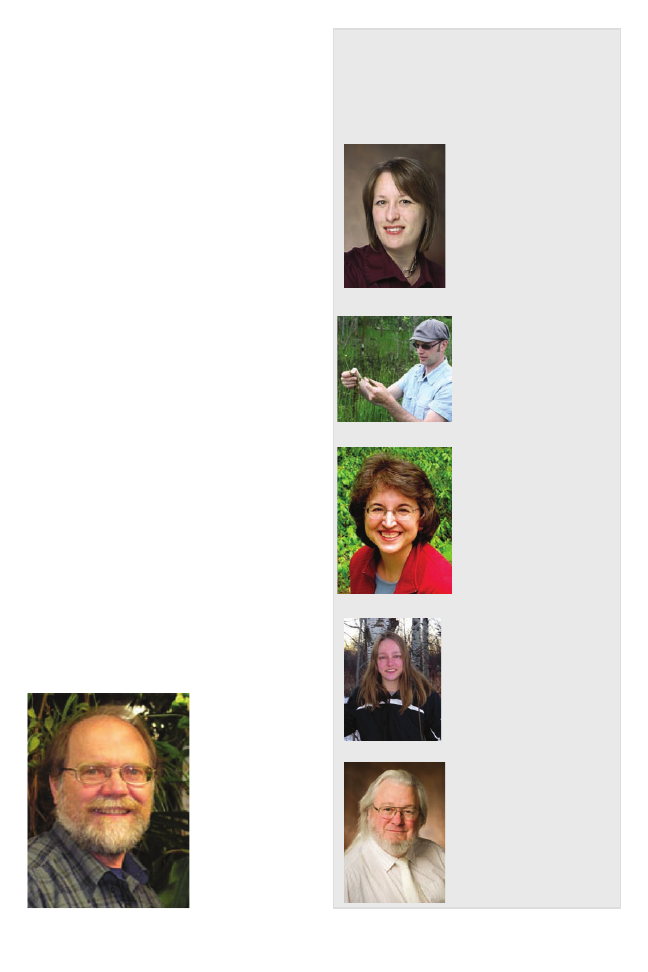
From the Editor
Winter 2013 Volume 59 Number 4
PLANT SCIENCE
BULLETIN
Editorial Committee
Volume 59
-
Marsh
Elizabeth Schussler
(2013)
Department of Ecology &
Evolutionary Biology
University of Tennessee
Knoxville, TN 37996-1610
eschussl@utk.edu
Christopher Martine
(2014)
Department of Biology
Bucknell University
Lewisburg, PA 17837
chris.martine@bucknell.edu
Lindsey K. Tuominen
(2016)
Warnell School of Forestry &
Natural Resources
The University of Georgia
Athens, GA 30605
lktuomin@uga.edu
Daniel K. Gladish
(2017)
Department of Botany &
The Conservatory
Miami University
Hamilton, OH 45011
gladisdk@muohio.edu
Carolyn M. Wetzel
(2015)
Biology Department
Division of Health and
Natural Sciences
Holyoke Community College
303 Homestead Ave
Holyoke, MA 01040
cwetzel@hcc.edu
In a recent commentary in Nature (503: 191–
192), Georgina Mace noted that the shift to
digital publishing is beginning to have a nega-
tive effect on scientific societies, such as the
100-year-old British Ecological Society, of
which she is Past-President. In great measure,
this is because most professional societies de-
rive a significant portion of their budget from
subscriptions to their scientific journal and
membership is declining. The Botanical Society
of America has been proactive in anticipating
these changes and increasing the value of mem-
bership for several years, and as a result we are
in a much better situation than many of our
sister scientific societies. It is timely, then, that
we begin this issue with the address presented
by President Pam Diggle at our annual meet-
ing last summer. Pam presents a brief history of
the role of learned societies, their journals, and
their meetings and brings this forward to the
role of the BSA, our professional journals, and
our annual meeting today. I am in full agree-
ment with Pam’s prediction for the future, and I
think you will be too. Read the article on p. 150.
Then, start planning for our next annual meet-
ing, Botany 2014 in Boise, Idaho. If you’re un-
decided at the moment, I understand that one
of the field trips may be to the Clarkia fossil
beds—check out Plants are Cool, Too! Episode
2: “Fossilized Forests” (https://www.youtube.
com/watch?v=YfRXDbtkEi0).
See you there!
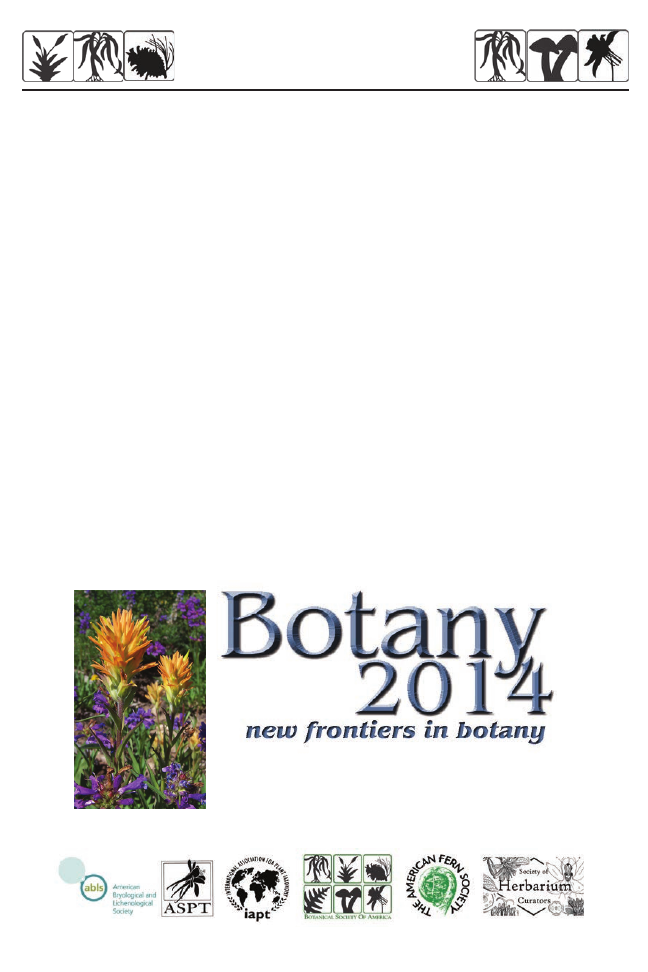
149
Table of Contents
Society News
Learned Societies - Past, Present and Future? Address of the BSA President at Botany 2013 ...150
The BSA Legacy Society Celebrated the Northeast .......................................................158
Is the BSA Legacy Society for you ................................................................................159
BSA Science Education News and Notes ....................................................
161
Editor’s Choice Review ...............................................................................
164
Announcements
In memoriam - Rudolf Mathias Schuster, 1921–2012 ....................................................165
Personalia – Claire Hemingway ....................................................................................169
Getty Research Institute Announces Gift of Rare Botanical Books ...............................170
Missouri Botanical Garden Announces Grant Award—Project Aims to Improve
Access to Digital Texts through Online Gaming .......................................................170
Plant Health Scientists Reiterate Support of Biotechnology on World Food Day .........171
The Second International Conference on Duckweed Research and Applications..........171
BSA Seeks Editor for Plant Science Bulletin – Deadline for Nominations Extended ...173
Reports
Use of Pollen to Identify Cattail (Typha spp.,Typhaceae) Taxa in Indiana ....................174
Book Reviews
Developmental and Structural ........................................................................................178
Economic Botany ...........................................................................................................179
Mycology ........................................................................................................................180
Systematics ....................................................................................................................181
Books Received ...........................................................................................
184
The Boise Center
July 26-30, 2014
www.2014.botanyconference.org

150
Society News
Learned Societies - Past,
Present and Future?
Address of the BSA President
from Botany 2013
Pam Diggle
University of Colorado
(The video of this talk is available at the BSA’s
Botany conference channel at http://www.youtube.
com/watch?v=f-zJmTX9Zp0.)
Why do we belong to scientific societies? Why
do we come to scientific meetings? As I prepared to
take on the role of President of BSA, I realized that
the answers to these questions were so important
that I wanted to devote my presidential address to the
answers. In this digital age, with so many different
options for sharing information and interacting
with colleagues, why do we hold meetings? Why
did 1100 of us travel to New Orleans? We could
have all put our talks on YouTube and tweeted about
our favorites without ever leaving our offices. What
is the role of meetings and of scientific societies
generally, and the Botanical Society of America
specifically, in modern science?
To explore this question of why we belong to
societies and why we come to meetings, I began by
asking a more general question: What is a scientific
society, or more generally, a learned society?
Reading through the literature on learned societies,
I found a variety of definitions. Learned societies
are…
• Knowledge networks…created to provide
a forum for learned individuals to share and
discuss knowledge and discoveries (McCarthy
and Rands, 2013)
• Primarily concerned with the pursuit of
knowledge and its dissemination to a wider
audience (Hopkins, 2011)
• Organizations that promote interaction
between scholars (Encyclopedia of Higher
Education)
• Publish the proceedings of their meetings,
journals, reports and outstanding investigations
by their members. They also award prizes,
encourage or subsidize research and maintain
libraries (Columbia Encyclopedia)
• A means through which interested parties are
able to access the combined expertise of many
universities and individuals in one space or for
experts to gather to have impact by collectively
expressing opinion on a particular topic
• Voluntary organizations of individuals
dedicated to scholarship and research, often
focused on a particular subject or method.
Common themes of these definitions include the
focus on the intake, exchange and dissemination of
knowledge, and interaction among individuals and
professional recognition. This is a good description
of the BSA as a modern Society, but how have
learned societies come to embody these properties;
how did these networks of knowledge and personal
interactions come about? What is the history of
learned societies?
Most historiographies trace the origins of
modern learned societies back to the Accademia
Secretorum Naturae, founded in Naples in 1560
by Giambattista della Porta. The society met in
della Porta’s home and membership was open to all
who could “present a new fact in natural science.”
This was a group who cared about knowledge and
came together to discuss and share knowledge
widely. The society’s activities became the subject
of an ecclesiastical investigation and della Porta
was ordered by Pope Paul V to close his Academy
in 1578 under suspicion of sorcery.
Giambattista della Porta, founder of the
Accademia Secretorum Naturae in 1560.
Membership was open to all who could
present “a new fact in natural science.”
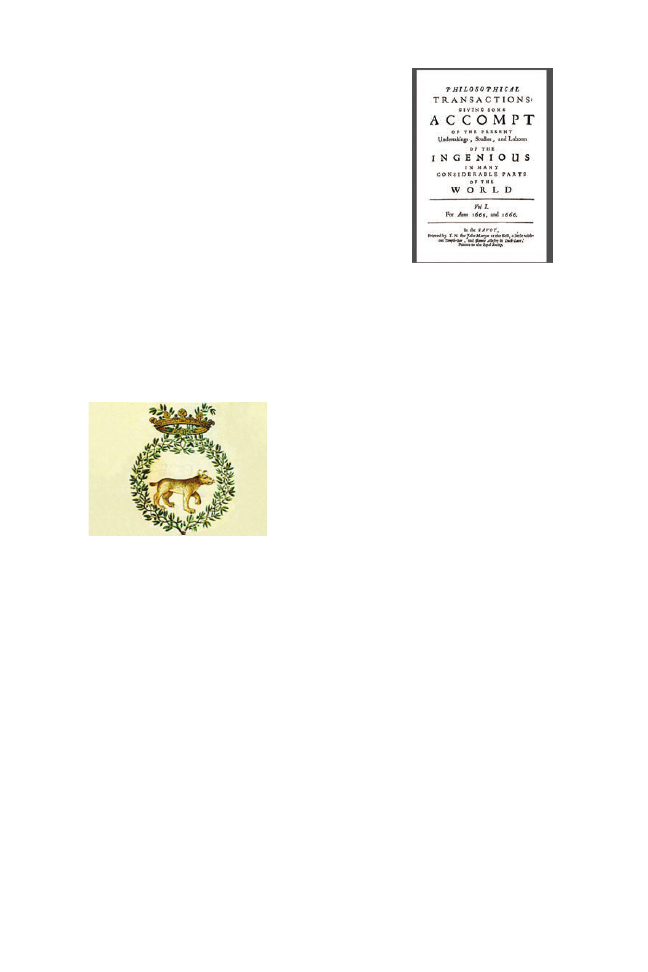
151
Plant Science Bulletin 59(4) 2013
Some 50 years later, Federico Cesi, who
was passionately interested in natural history,
particularly botany, founded another academy, the
Accademia dei Lincei, in Rome. The academy was
named after the lynx, an animal whose sharp vision
symbolizes the observational prowess that science
requires. The society’s purpose was the “acquisition
of wisdom and knowledge of things… and the
announcement of these to men by both word and
voice.” They undertook individual projects and
investigations, kept members informed about what
happened in meetings, and established a library.
Perhaps most importantly, they established an ideal
to be emulated, that of a community of scholars
in constant free and open contact. Galileo Galilei
was a prominent member. The society did not
long survive the death of its founder Cesi, but was
resurrected in modern times, and you can read
more about it at www.lincei.it.
The Accademia dei Lincei inspired the
establishment of multiple learned societies across
Europe. Groups of people everywhere gathered to
discuss science and new knowledge. In England,
1660 saw the establishment of a society that
persists to this day: the Royal Society of London
for Improving of Natural Knowledge. The society
was founded by a small number of men (alas, this
history is mostly about men), including physicians
and natural philosophers, who began meeting in
a variety of localities around London and Oxford.
The society was granted a royal charter by King
Charles II, but the government did not support the
Society. In fact, to this day most learned societies
are not supported by any governmental entity;
they are volunteer organizations and sustained
by members. The members of the nascent Royal
Society met weekly to discuss science and they
even demonstrated new scientific devices and ran
experiments at these meetings. They read their own
papers, which described new discoveries, to each
other and presented papers that they received from
scientists on the continent. The Society’s motto,
Nullius in verba, is Latin for “Take nobody’s word
for it” and signifies the Fellows’ determination to
establish facts via experiments. This early genesis
of the Royal Society occurred within the context of
the Enlightenment. The members understood that
they could create new knowledge, that they could
discover new things about the natural world.
The scientific journal originated with the scientific
societies of the seventeenth century. Journals as we
know them today were created by these societies as
a means of rapid communication among members,
to make their collective findings generally available
to other interested groups, and to provide a venue
to inform members about activities and findings
of other societies. Journals also became important
repositories of scientific information, providing
a dependable and permanent record. The close
relationship between societies and journals has
been critical to the stability of journals over the
long run. Societies are sustained by groups of
people that care very deeply about science, and for
that reason, they are committee to the journals that
communicate their science.
In the middle of the seventeenth century,
however, it was not at all obvious that journals
would become the appropriate place for scientific
The emblem of the Accademia dei Lincei, founded in
1603, by Federico Cesi. The academy was named af-
ter the lynx, an animal whose sharp vision symbol-
izes the observational prowess that science requires.
The first issue of the Philosophical Transactions of
the Royal Society of London. Journals were created
by societies to share information with members and
to make their collective findings generally available
to other interested groups. Journals became impor-
tant permanent repositories of information.

152
Plant Science Bulletin 59(4) 2013
publication. At that time, scholars wrote books
and treatises—big fat tomes of information
that were published and circulated among the
learned. Publishing books was the accepted
means to establish a reputation as a scholar and
for communication of knowledge. There was no
precedent for the publication of credible knowledge
in periodical form. In fact, “periodical” and
“journal” did not exist as nouns to describe a type
of publication! A modern scholar who studied the
practice of publication in the seventeenth century
(Johns, 2000) raised the question: in this period,
why should anyone interested in producing secure
knowledge ever think to do so by means of transient
publication such as this? Most of what was printed
in a journal-type format was intended as ephemera.
They included broadsheets that carried gossip and
news, and these publications weren’t thought of as a
means of communicating dependable information.
Establishment of the scientific journal in its
modern form is the result of a synergy between two
needs. On the one hand, the members of the Royal
Society (and other societies) were very much in
need of rapid communication with one another and
exchange of information internationally. On the
other hand, the printers really needed a dependable
income. The printing field was rife with plagiarism
and there was no copyright. Printers would go to
all of the trouble and expense of creating scholarly
books and the minute they were for sale, another
printer would typeset them, print them, and sell
them in competition with the original printer.
The pace at which journals were published meant
that there was always fresh material to print. This
mutual need of societies and printers for regular
publication created the scientific journal as we
know it today.
By the mid 1700s, there were many different
learned societies across England and Europe, and
there were many journals. Mail was dependable,
and distribution of journals to members within
societies and exchange of journals among societies
kept members informed about new developments
in science. The system of exchange of information
was so well established that you could sit in your
armchair in front of the fire, read your journals,
learn about the exploration going on all over the
globe about new experiments and discoveries, and
you could carry on a correspondence with people
of like mind. You did not have to go to meetings.
But that’s not what happened.
People continued to form both formal and
informal learned societies and to meet to advance
science. I’ll give two examples of informal societies
that had a significant impact on science. The first
is the Lunar Society, a group of men who met in
the British midlands around Birmingham in
the late eighteenth century. It was an informal
society of prominent men, including industrialists,
natural philosophers, and intellectuals. They were
interested in basic science and natural history,
but they were also businessmen and they had a
practical focus. Their goals included improving
manufacturing machinery and building canals
so that they could distribute their products more
efficiently. In some histories, the origin of the
industrial revolution is traced to these men. They
called themselves the Lunar Society (and cheerfully
referred to themselves as “lunatics”) because they
met during the full moon; the extra light made the
journey home safer in the absence of street lighting.
These people all had day jobs, yet meeting with
one another was so important that they ventured
out at night by horseback or carriage and had to
travel back home by moonlight. The Lunar Society
included Matthew Boulton, who, along with James
Watt, invented the steam engine; Joseph Priestley
who experimented with electricity and oxygen
and was also a clergyman; and Erasmus Darwin, a
Newspaper from 1643. In the seventeenth century
periodical publications were primarily newspapers
and broadsides. They were not considered reliable
and permanent repositories of information. Image
from The British Library, E.104.(3.) Copyright
©1999, The British Library Board
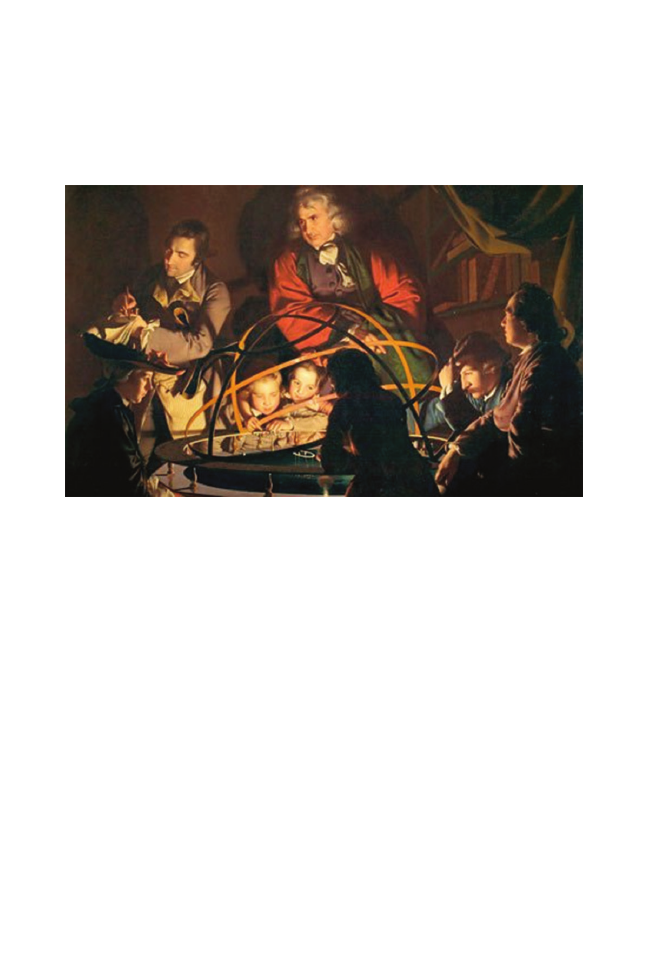
153
Plant Science Bulletin 59(4) 2013
natural philosopher and a physician (and Charles
Darwin’s grandfather). Despite, or perhaps because
of, their diverse interests and professions, these
men very much valued each other’s company and
traveled long distances to meet and discuss science.
Skipping ahead 100 years to mid-nineteenth
century, and going back to central London, my
second example of an informal society is the X
Club. By this time, the Royal Society and other
prestigious societies such as the Linnean Society
of London had been well established for over 200
years and their meetings and journals functioned as
dependable sources of information about science.
Yet, informal clubs and societies continued to form
in London to facilitate more intimate discussions
and interactions. In 1864, a group of nine men,
calling themselves the X Club, began to gather
over dinner once a month. All were members
of other learned societies, but still felt the need
to gather together in an informal setting. The X
Club began to meet soon after the publication of
Charles Darwin’s On the Origin of Species by Means
of Natural Selection, and in the midst of the debates
between the clergy and the scientists over Darwin’s
ideas. The members of the X Club described
themselves as “united by a devotion to science, pure
and free, untrammelled by religious dogmas.” In
addition to discussion of science, a key aim was to
make the practice of science professional. At that
time, the word “scientists” had just been coined and
there was no such profession as scientist. The X
Club was instrumental in creating paid professional
positions for scientists. You’ll recognize many of
the members: Thomas Huxley, Joseph Hooker,
Herbert Spencer, John Lubbock, and John Tyndall.
The word “scientist” was coined in the 1840s (the
date is uncertain) by William Whewell at a meeting
of the British Association for the Advancement of
Science. Before then, people who did science were
referred to as “natural philosophers” or “men of
science.” The very word we use to describe what we
are (scientists) was born at scientific meetings, and
science as a profession owes much to the activities
of scientific societies such as the X Club. Moreover,
I would argue, the genesis of science as we know it
today occurred in the academies and societies that
originated in the middle of the seventeenth century.
Modern science did not originate in universities.
The universities of the time were fairly moribund.
To learn in a university was to study the classics
and to master received wisdom. Creation of new
knowledge was not a goal of university education.
“A Philosopher giving a Lecture on the Orrery in which a lamp is put in place of the Sun,” a painting
by Joseph Wright of Derby. This portrays a key idea of the Age of Enlightenment: science grounded
in empiricism and reason.
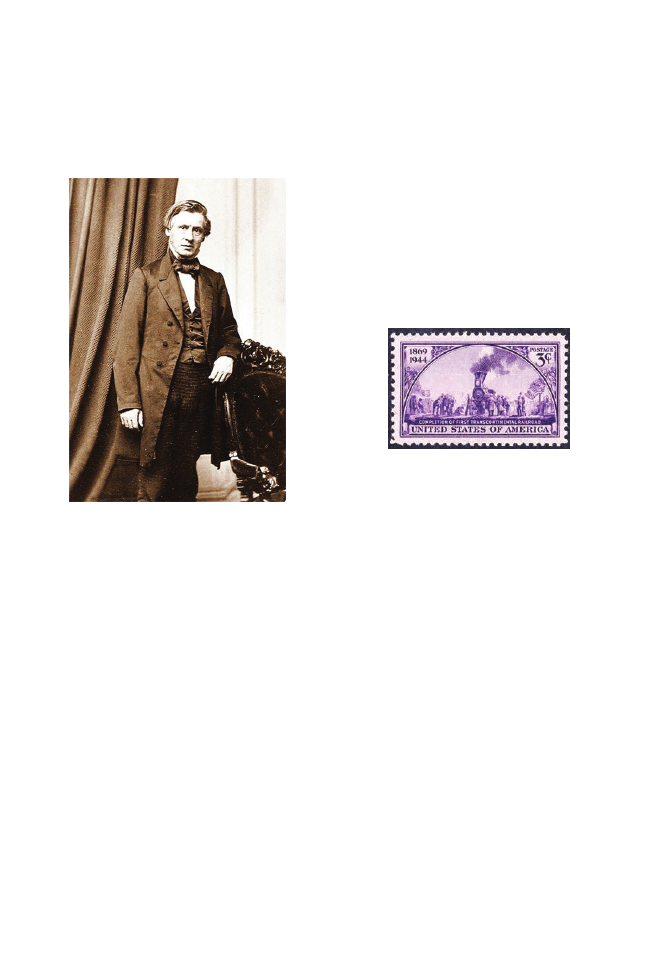
154
Plant Science Bulletin 59(4) 2013
Modern science originated with the enquiries and
activities of scientific societies. The very notion
of faculty as members of the “academy” and the
words “academic” and “academician” derive from
the association of new knowledge with learned
academies and societies.
Turning from England to the other side of the
pond, we were not dozing. In the colonies, even
before the United States became a country, the thirst
for knowledge and curiosity about the natural world
was satisfied by the formation of learned societies.
As early as 1739, the botanist John Bartram made
the first proposal to form a general scientific society,
but it took Benjamin Franklin to accomplish this
goal. Franklin wrote, “The first drudgery of settling
new colonies is now pretty well over, and there are
many in every province in circumstances that set
them at ease, and afford leisure to cultivate the finer
arts, and improve the common stock of knowledge.”
He volunteered his services as secretary and the
American Philosophical Society was established in
Philadelphia in 1743. The members were diverse,
including doctors, lawyers, clergymen, artisans
and tradesmen and included many founders of
the republic: George Washington, John Adams,
Thomas Jefferson, Alexander Hamilton, Thomas
Paine, Benjamin Rush, James Madison, and John
Marshall. Not to be outdone by Philadelphia, John
Adams wanted a learned society for Boston and
convinced the Boston legislature to establish the
American Academy of Arts and Sciences in 1780.
The purpose of the society was “to cultivate every
art and science which may tend to advance the
interest, honor, dignity, and happiness of a free,
independent, and virtuous people.” The American
Academy, like the American Philosophical Society,
had a diverse membership including scientists,
writers, and artists, and many founding fathers
were members.
In the early history of the United States, learned
societies were general societies and members were
elected; they were fairly exclusive. Only in the mid-
1800s did more focused societies develop with
a more egalitarian approach and more inclusive
membership. In 1848 the American Association
for the Advancement of Science (AAAS) was
established to focus more specifically on science
and was open to all. The constitution states that
“the objects of the Association are, by periodical
and migratory meetings, to promote intercourse
between those who are cultivating science in
different parts of the United States; to give a
stronger and more general impulse, and a more
systematic direction to scientific research in our
country; and to procure for the labours of scientific
men, increased facilities and a wider usefulness.” At
its very inception, the AAAS focused on the critical
role of meetings as a means of advancing science.
They also clearly understood the importance of
holding meetings in different locations to serve
members from across the country. AAAS took
the idea of moving the meetings around very
seriously. For example, in 1872, Asa Gray of
Harvard University was president of the AAAS.
Although Gray lived and worked in Cambridge,
Massachusetts, the meeting was planned for San
Francisco, California. The transcontinental railroad
Asa Gray, botanist and early supporter of Darwin’s
evolutionary theory was elected president of AAAS
in 1872. He planned to travel 3,000 from Mas-
sachusetts to California on the newly completed
transcontinental railroad to attend that year’s
meeting.
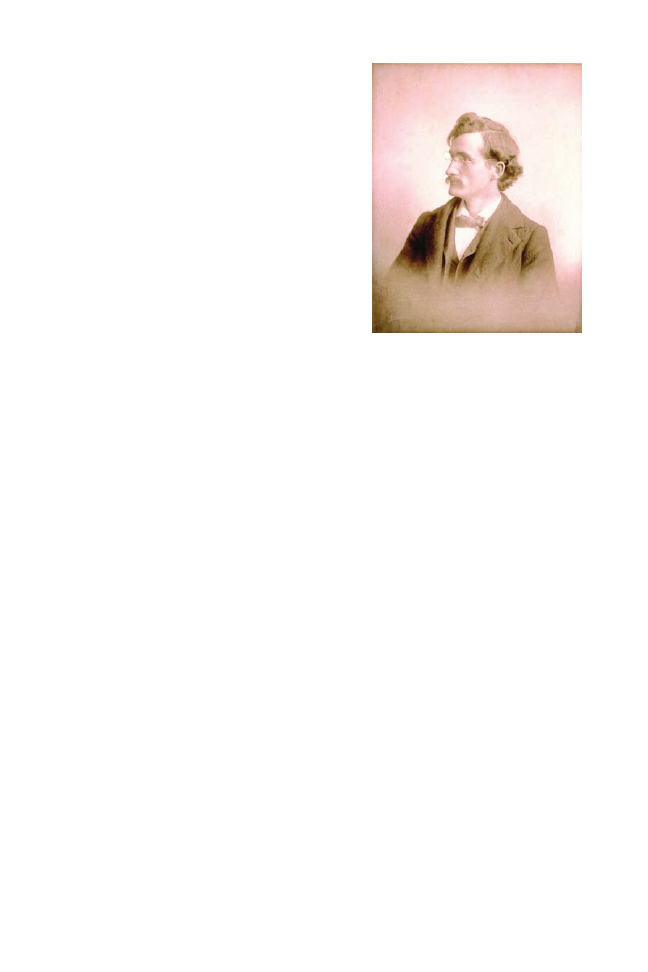
155
Plant Science Bulletin 59(4) 2013
had only been completed three years earlier, in 1869.
Yet, Gray and presumably many other members of
the AAAS, planed to travel 3,000 miles on a newly
completed rail line to go to a meeting! In the end,
the society was unable to negotiate reasonable train
fares from the east and they split the difference
and met in Dubuque, Iowa. This is a tale of true
dedication to scientific meetings.
The Botanical Society of America grew out of
AAAS. During the 1883 meeting in Minneapolis,
members formed the Botanical Club as a section of
the AAAS. It functioned within the AAAS for about
10 years, but at their 1892 meeting, Liberty Hyde
Bailey of Cornell University suggested forming a
new society of botanists to “unify and subserve the
botanical interests of the country.” Bailey chaired a
committee to investigate formation of an American
Botanical Society and they carefully weighed all
of the issues. At the next meeting of the Botanical
Club, Bailey presented the committee report: by a
vote of 8 to 2 the committee recommended against
establishment of a separate American Botanical
Society. But, one of the two committee members
who were in favor of forming a separate society
gave his opinion, and he must have been very
persuasive because two thirds of the members
voted to form a society! The Botanical Society of
America was established in 1895, with the aim of
promoting botanical research. Interestingly, in the
original charter the society moved away from the
egalitarian approach of the AAAS, and membership
was by election and restricted to active researchers.
This troubled some botanists, and in 1897 members
of the American Society of Naturalists organized a
different botanical society: the Society for Plant
Morphology and Physiology. Fractionation was
also troubling, and the 1906 meeting in New
Orleans, Louisiana saw a union of three societies.
The Botanical Society of America, the Society
for Plant Morphology and Physiology, and the
Mycological Society gathered forces and became
the Botanical Society of America. William Trelease
and Charles Bessey were the first two presidents of
the new BSA. L.H. Bailey was elected president in
1926; they must have eventually forgiven him for
recommending against formation of the BSA in the
first place.
At the very first meeting of the BSA in 1906,
members appointed a publications committee and
began to discuss the critical need for a journal
to publish the results of BSA members and to
disseminate them widely. Volume 1 of the American
Journal of Botany was published in January of 1914.
In 2014 we will celebrate the centennial of the AJB;
watch the journal for exciting developments as the
year unfolds.
Since its birth in the learned societies of the
enlightenment, science has changed and grown.
Science is an enormous engine of our modern
economy and holds a central place in higher
education. Importantly, science increasingly bears
great responsibility to share its knowledge and
values with the public. As science has grown and
become more complex, scientific societies have
also grown and matured and continue to foster
and support science in multiple ways. The BSA is
now a thriving and complex organization of 3000
members that support each other in multiple
ways. The BSA includes members from around the
world, from multiple career stages and multiple
professions within the botanical sciences. The BSA
is egalitarian; all botanists are welcome as members
and anyone can present at the annual meetings.
In this age of horizontally organized academic
departments, we are a vertically integrated
society and our journal and meetings provide an
important opportunity to read broadly and to
interact with colleagues who work at very different
scales, from molecules to ecosystems. In addition
to the American Journal of Botany, the society
publishes the Plant Science Bulletin for informal
communication, with information on upcoming
At an 1892 AAAS/Botanical Club meeting Professor
L. H. Bailey suggested that a new society of botanists
be established to “unify and subserve the botanical
interests of the country.” He ultimately voted against
forming the Botanical Society of America.

156
Plant Science Bulletin 59(4) 2013
meetings, courses, field trips, news of colleagues,
new books, and professional opportunities, and the
brand new, online, open access journal, Applications
in Plant Sciences (APPS), for communication of
innovative tools and protocols. The BSA fosters
the careers of our members with multiple awards
and recognition, and supports travel and research
for our graduate students. The society is active
in development of programs that will enhance
botanical education at the K-12 level (Planting
Science) and undergraduate level (PlantED) and is
increasingly involved in providing a collective voice
concerning policy issues. The BSA website (
botany.org) records 250,000 hits per month, and
reaches others via e-news and social media. The
Society has over 6,300 Facebook and 1,800 Twitter
followers. By the second day of the 2013 meeting,
over 1000 Tweets carried #Botany2013.
But everything on this list can be done online.
So, I come back to the question that I started with:
Why do we come to meetings? 1100 people came to
the meeting in New Orleans; botanists came from
49 states of the US and from 35 other countries.
Why?
From the Royal Society, to the Lunar Society,
to the X Club, to the BSA, we come to meetings.
Certainly, we all want to share information and
research with scientists and educators from around
the world. But the heart and soul of a society, what
makes us attend meetings, is shared fellowship. We
want to make personal contacts, we come to share
ideas and information, we come to experience that
completely unexpected and unsought insight that
comes from serendipitous interactions, for the
intense sustained conversations that occur in the
hallways. We come to work through experiments
over a beer, to better understand our own data, to
figure out how someone else did that, how someone
else taught that. Over 450 years after the initial
gatherings at the home of della Porta in Naples,
gatherings are still part of the essence of science
and of being a scientist. The same impulse that
drew the lunar men out into the dark night, or Asa
Gray to contemplate a 3,000-mile journey at the
dawn of the transcontinental railroad, draws us to
meetings all over North America.
I sent out a query during the 2013 New Orleans
meeting to all of the users of the new mobile
meeting app asking “Why are you here?” Almost
every response included “make new connections”
and “reconnect with friends and colleagues.” Sure,
we can interact and collaborate online, and we
do. But, we are not avatars. And so we come to
meetings. This was true in 1560, it’s true today, and
I am confident that it will be true into the future.
While innovative technology and the digital world
are clearly critical to science, it is societies and
meetings that make us complete as scientists.
Bibliography
To assemble this address, I consulted with many
different sources, including the websites of the
individual societies and the following references:
Barton, R. 2003. ‘“Men of Science”: Language,
Identity and Professionalization in the Mid-
Victorian Scientific Community’. History of
Science 41:73–119.
Crane, D. 1972. Invisible Colleges: Diffusion of
Knowledge in Scientific Communities. Chicago:
University of Chicago Press.
Geiger, R. L. 1986. To Advance Knowledge: The
Growth of American Research Universities,
1900–1940. New York: Oxford University Press.
Gross, A. G., J. E. Harmon, and M. Reidy. 2002.
Communicating Science: The Scientific Article
from the 17th Century to the Present. Oxford.
Hopkins, J. 2011. The role of learned societies
in knowledge exchange and dissemination:
the case of the Regional Studies Association,
1965–2005. History of Education: Journal of the
History of Education Society 40(2):255–271.
Volume 1 of the American Journal of Botany ap-
peared in 1914. We will celebrate our journal’s cen-
tennial next year!

157
Plant Science Bulletin 59(4) 2013
Johns, A. 2000. Miscellaneous Methods: Authors,
Societies and Journals in Early Modern
England, British Journal for the History of
Science 33:159–186.
McCarthy, D., and M. Rands. 2013. Learned
societies: a bridge between research, policy
making and funding. Studies in Higher
Education 38:470–483.
McClellan, J. E., 1985. Science Reorganized: Scientific
Societies in the Eighteenth Century. New York:
Columbia University Press.
Morrell, J. B. and A. Thackray. 1981. Gentlemen of
Science: Early Years of the British Association for
the Advancement of Science. Oxford.
Ornstein, M. 1913. The Role of Scientific Societies
in the Seventeenth Century. Dissertation,
Columbia University, New York.
Secord, A. 1994. Corresponding Interests: Artisans
and Gentlemen in Nineteenth-Century Natural
History, British Journal for the History of Science
27:383–408.
Secord, A. 1994. Science in the pub: Artisan
Botanists in Early Nineteenth-Century
Lancashire. History of Science 32:269–315.
Secord, J. A. 2007. How Scientific Conversation
Became Shop Talk. Transactions of the Royal
Historical Society 17:129–156.
Smocovitis, V. B. 2006. One Hundred Years of
American Botany: A Short History of the
Botanical Society of America. American Journal
of Botany 93:942–952.
Stuckey, R. L., and E. D. Rudolph. 1974. History
of Botany, 1947-1972; with a Bibliographic
Appendix. Annals of the Missouri Botanical
Garden 61:237–261.
Tippo, O. 1956. The Early History of the Botanical
Society of America. American Journal of Botany
43:852–858.
White, P. 2003. Thomas Huxley: Making the ‘Man of
Science’. Cambridge.
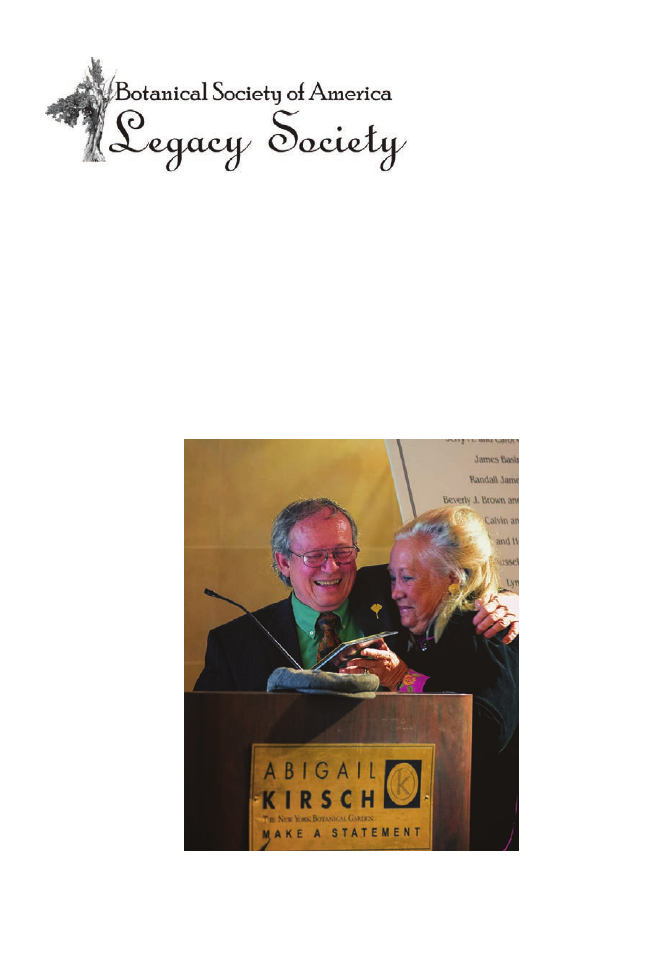
158
Plant Science Bulletin 59(4) 2013
The BSA Legacy Society Celebrated the Northeast
A beautiful October evening at the New York Botanical Garden was the setting for a heartwarming
commemoration dinner for some life-long BSA members from the Northeast region. This long-overdue
and very special celebration honored the outstanding contributions to science, education, and the Society
on the part of these members. Legacy Society member and Vice President for Laboratory Research of the
New York Botanical Garden, Dr. Dennis Stevenson, graciously hosted the evening of commemorations,
and the private tours of the Pfizer Laboratory and the New York Botanical Garden the following day.
Members from all parts of the Northeast region came together for the event in order to take part in
honoring these very special members.
If you are not familiar with the BSA’s Legacy Society, it is a growing group of members from all
generations who are committed to sustaining the century-old Society in perpetuity. The Legacy Society has
held commemoration events in the Midwest and Northeast regions over the past two years, and plans to
hold additional events in more regions throughout the country in the near future.
Legacy Society member Dennis Stevenson thanks Anitra Thorhaug
for her service and presents her with her commemorative plaque.

159
Plant Science Bulletin 59(4) 2013
And Dr. Weller went on to issue a challenge to
every BSA member, “If you think the work we do
as botanists is important, step up and be sure it has
sound financial footing.”
Dr. Anitra Thorhaug of Miami, now retired, calls
the Botanical Society her “intellectual botanical
home,” and is far from shy about her opinions on
giving. “It’s already in my will,” she says. “It’s not
too early to start thinking about what your legacy is
going to be. Do it when you are young enough and
have energy enough,” she said.
Dr. Dennis Stevenson of New York is part of the
team working to build the Legacy Society for the
next generation. “As you become a senior person, it’s
your turn,” he says, talking about the connections
made through a career in botany and the need to
support the generations of incoming botanists with
a strong organization.
“BSA has been such an important part of my
development, it’s important to give back,” says Dr.
David Spooner of the University of Wisconsin
at Madison. “The Legacy Society is important to
highlight the contributions and pave the way for
younger members.
“The future is in the students,” says Dr. Janice
Coons of Eastern Illinois University in Charleston,
IL. “If we don’t involve them in the Legacy Society,
we won’t have it.” What that means, she explains, is
that all botanists learn that there is a need to give.
Giving can be through annual donations of any
size and through an estate gift. For Dr. Coons, the
gifts would mean a future where the Society could
expand without financial constraints to put its ideas
in motion.
A key when the discussion of younger member
participation comes up is how to get them involved,
or how much to ask. “Any level of participation
is appreciated,” said Dr. Judy Jernstedt of the
University of California at Davis. “A small donation
is still representative of a tradition of philanthropy,
and it will grow along with a career,” she said. “And,
it’s a satisfying trajectory to be on.”
Point being, there is something for everyone.
Dr. Calvin Clyde and Dr. Carol Wilson, both of
Rancho Santa Ana Botanic Garden in Claremont,
CA, talk about their decision as a couple to become
involved in the Legacy Society. “Money talks and
The founders of BSA’s Legacy Society have a
vision for putting together a financial platform that
would take the organization into fiscal security for
the foreseeable future. And beyond.
Between them, there was a firm sense that their
combined voices would convince others in the
botanical sciences that they could, and should,
bequeath that sound future. Everyone. Not just the
gray hairs, as they call themselves, and most senior
of the scientists. Everyone has something to gain
in this precious legacy, and therefore they struggle
to show that the Legacy Society is for everyone.
Relevant could be the key word they choose.
Dr. Jim Seago of State University of Oswego, NY,
said it was just “natural” to want to give back to the
Society that had given him so much opportunity.
What he hopes is that he can influence others to
have that same thought.
As part of the Legacy team in BSA that has
brought giving from 30 individuals up to 151
people in just a few years, they believe they are
getting their message out. The Legacy Society is
about being responsible and planning for the future
of the Society.
Dr. Joe Armstrong of Illinois State University
at Normal, IL, and his wife Nancy are strong
supporters of the Legacy Society and combine
their ideas of professionalism and support in their
reasoning for putting their financial backing there.
“It’s just part of being professional and being active
in the Society,” says Dr. Armstrong. And Mrs.
Armstrong adds, “It’s about support for me. I see
what the profession has done for my husband and
the other people I know, and it’s the right thing to
do.”
Dr. Ann Sakai of the University of California
Irvine echoes those sentiments, saying, “I’ve gained
a tremendous amount from botany and the Society
from the time I started my career to now and this is
one way of giving back.”
Her husband, Dr. Steve Weller, also with the
University of California Irvine and Past President
of BSA, said that he would like to see the Legacy
Society expand its reach to include a broader
group in BSA. “We’ve become a broader group
demographically and I’d like to include more
people in our work. It’s not just about fairness, but
also about our work and getting it done,” he said.
Can BSA’s Legacy Society Include You?

160
Plant Science Bulletin 59(4) 2013
the larger the endowment of the BSA, the bigger
impact it can have,” Dr. Clyde said. “BSA should
have a larger endowment to create more focus on
the economic importance of plants.”
Dr. Wilson, admittedly shy, said botany and
particularly the Botanical Society “has always been
there for me. I want botany to be there always for
others too.”
The couple thinks the Legacy Society creates a
culture of giving where it becomes a habit to give
regularly. “The thought of not giving regularly to
BSA is foreign,” Dr. Clyde said, with Dr. Wilson
chiming in that “we not only get a lot out of it, but
also learn to be generous.”
Dr. David Lee of Florida International University
in Miami said it succinctly. “Your loyalty should
be to your discipline, even more than to your
institution,” he said, comparing giving to BSA to
alumni associations.
It’s a valid comparison, says Dr. Ed Schneider
of the University of Minnesota, who would love
to see many of the professors begin to talk to their
students about giving to the Society as an important
thing to do. “The BSA voice is not enough,” he
explained. “But when your mentor talks about it,
that’s different. The universities do it, they need to
do it, and so do we. We plant and germinate a seed,
and when that student is in a position to give, they
will.”
Dr. Scott Russell of the University of Oklahoma
in Norman added that both the continuity of
continued gifts and new gifts will be important to
the growth of the Legacy Society. And those are
mostly likely to come from the young botanical
scientists. So what do the young scientists think?
Dr. Mackenzie Taylor of Creighton University
in Nebraska, who just received her post-doctoral
degree and was a former student representative on
the BSA Board, said she sees the Legacy Society as
something for people on the edge of retirement.
With head cocked, waiting to hear if there was
something more, she said she would definitely
listen if there was some way to participate.
Dr. Chris Martine of Bucknell University in
Lewisburg, PA, an active volunteer and strong
supporter of the Society, said his impression was
that the Legacy Society was for the older members.
Even the word “legacy” might send the wrong
message, he thought, but his interest was piqued.
The ability to be welcomed among and supportive
of the Society’s most elite and to know they would
be building the future is a message Dr. Martine
believed would reverberate.
So, for the Legacy Society, a platform of growth
means broader participation, inclusive messaging
and, as Chris Martine would say, “botanical giving
is cool!”
Is Legacy Membership for You?
Being a Legacy Member is easy.
Just list the Botanical Society of America as a component in your legacy gifts.
It’s that simple—no minimum amount, just a simple promise to remember the
Society.
Giving a legacy gift to the BSA is simple. You include a bequest to the BSA in
your estate plan and/or sign up to give an annual gift and notify us by filling out
a short form found at botany.org/legacy/BSALegacyForm.pdf.
All levels of gifts made to the Botanical Society of America are significant, and
help us continue and further our mission.

161
BSA Science Education
News and Notes
New and Ongoing Society
Efforts
PlantED Digital Library
Call for botany teaching and learning resources:
Resource Editors J. Phil Gibson and Stokes Baker
look forward to your submissions to the digital
library. Inquiry activities, data sets, syllabi, images:
these are only a few of the materials welcome. If
you have resource to contribute, we’re here to help
you share it. Below we highlight an active learning
lab.
Roots as Foragers by Stan Rice helps students
experience plants as responsive rather than passive
organisms. Roots forage through heterogeneous
media and proliferate in portions of the soil that
have abundant nutrients. Students can see and
measure this growth. Students also get to address
issues of experimental design such as the sequence
effect. This lab is highly adaptable to address the
broad question of how plants actively respond to
the environment—phytoremediation and climate
change are just some of the possible real-world
issues of spatial and temporal heterogeneity of
the environment can be connected to student
investigation of root growth. Download the lab
activity with discussion of student data and ideas at
PlantED, http://planted.botany.org.
PlantED, the BSA’s new resource portal, is run
in conjunction with companion portals of the
Ecological Society of America (ESA), the Society
for Economic Botany, and the Society for the Study
of Evolution. Peer-reviewed resources in PlantED
will be searchable across these four portals and
included in the National Digital Science Library.
Your resource supporting botanical education
could reach a wide audience.
Resources across the collaborative effort will be
showcased on a quarterly basis in Jigsaw, which is
produced by the ESA monthly. Jigsaw was a joint
issue this past October and contained a special
feature on Climate Change. Profiled resources
in addition to Roots as Foragers include: Leaves
as Thermometers, What Does Agriculture Have
to do with Climate Change?, and What NOT
to Read: A Lesson in Reviewing and Critiquing
Scientific Literature Using a Junk Science Article on
Climate Change. To access all resources, reports,
and announcements in the October issue and
archives of Jigsaw, please visit http://www.esa.org/
esa/?page_id=7656.
PlantingScience Fall Session
Going Strong - New Resources,
Partners Profiled
Over 200 teams were online this fall, working
on plant investigations with their scientist
mentors. This year the Ecological Society of
America joined the American Society of Plant
Biologists and Botanical Society of America in
sponsoring graduate students/post-doctoral
researchers to make yearlong commitments as
members of the Master Plant Science Team.
Mentors of all stripes often wonder about the
impact of their online conversations with student
teams. Participating teachers, who witness first-
hand the learning benefits for students, can assure
mentors they are making a difference:
• “Thanks for all you do. My kids are growing
alongside their plants :)”
• “My 9th/10th graders thought it was the best
thing they had ever done in a science class ever!”
BSA Science Education News and Notes is a quarterly update about the BSA’s education efforts and the
broader education scene. We invite you to submit news items or ideas for future features. Contact: Catrina
Adams, Acting Director of Education, at CAdams@botany.org or Marshall Sundberg, PSB Editor, at psb@
botany.org.
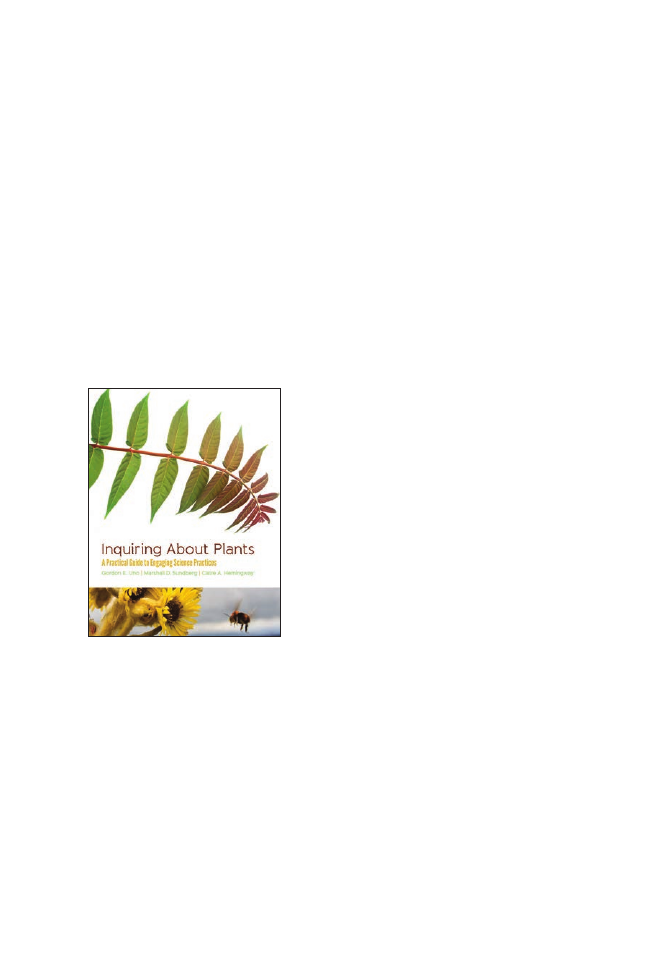
162
Plant Science Bulletin 59(4) 2013
We are excited to announce some new resources
on www.plantingscience.org. We have added
extensive “Roadmap through an Investigation”
for students, teachers, and scientist mentors that
covers diverse aspects of doing and communicating
science from exploring initial ideas to making final
presentations. Also available is a downloadable
“Plant Investigation Toolkit” with help on topics
ranging from “Using Math” to “Plant Care” to
“Imaging Technology.” You’ll also see a “Partners’
Links” section featuring resources for teaching
and learning about plants, and information about
science careers. A new “About” section describes
partners and society liaison contacts.
If you haven’t visited www.plantingscience.org
lately, please stop by! Take a look at the project
gallery to see how students are progressing with
their projects, or browse the new resources.
An additional resource, which is an outcome
of the National Science Foundation grant that
supported the project from 2007-2013, will be
available this winter. Inquiring About Plants: A
Practical Guide to Engaging Science Practices by
Gordon Uno, Marshall Sundberg, and Claire
Hemingway complements PlantingScience but is
a stand-alone resource for high school and college
science educators. The book offers classroom-
tested tricks of the trade for drawing students
into practice of science, focusing courses on the
big ideas of biology and student understanding of
these ideas, and creating your own inquiry-based
activities. It is due out by December 20132013,
and proceeds of the $10.95 book will go to support
PlantingScience.
Broad and Diverse
Participation in Botany
In line with the mission and objectives of
the Society, the BSA was awarded the PLANTS
grant (2011-2015, A. Sakai and A. Hirsch, co-
PIs) by the National Science Foundation to bring
undergraduates from a diversity of backgrounds
to the annual Botany meetings. The goal of this
grant is to increase the number of undergraduates
from underrepresented groups who attend
these meetings, and to increase their level of
academic excellence and motivation to pursue
advanced degrees in the plant sciences. Thus far,
37 students have participated in the PLANTS
programs, and the great majority of these students
who have graduated are now in graduate school
or botanically related professions. The success
of this program is largely due to the generous
commitment of volunteer graduate students,
postdocs, and professional mentors at the meetings.
We encourage members to publicize this program
to interested undergraduates and to consider
becoming a mentor for this program for BOTANY
2014. Applications for the 2014 meeting in Boise,
Idaho, will be accepted beginning February 1
and due by March 15, 2014. For details, please
see http://botany.org/awards_grants/detail/
PLANTS.php.
At BOTANY 2013, the “Broadening Participation-
Recruiting and Retaining Outstanding Scientists
in the Botanical Sciences” symposium (A.
Monfils, A. Sakai, organizers) explored some of
the best practices to encourage recruitment and
retention of all students, and particularly URM
(underrepresented minority) students. Speakers
discussed successful teaching approaches in the
introductory core biology courses, mentoring
strategies for students and academics, recruitment
of a diverse community of scientists, overcoming the
dual hurdles of science and technology as it relates
to current digitization initiatives, and curricular
and institutional programs to promote diversity in
the sciences. This symposium was sponsored by
the BSA Ecology, Teaching, and Systematics/ASPT
sections as well as by iDigBio. The BSA Human
Diversity Committee invited Muriel Poston as
the featured speaker for the Enhancing Scientist
Diversity in Plant Biology Luncheon, who spoke on
‘Cultivating the next generation of plant biologists:
Opportunities and challenges’. Presentations from
the symposium by Judith Skog, Henry Bart, Mary
McKenna, Jose Herrera, David Haak, and Chris

163
Plant Science Bulletin 59(4) 2013
O’Neal, along with the talk by Muriel Poston, are
available online. In addition, you’ll find resources
on understanding and overcoming implicit bias at
http://botany.org/diversity/.
In early October 2013, the BSA and the American
Society of Plant Biologists shared sponsorship of
a booth and symposium at the annual SACNAS
meeting (The Society for the Advancement of
Chicanos and Native Americans in Science). The
Symposium, “Living with Neighbors: How plants
cope with other organisms” was well attended.
BSA also sponsored two undergraduate poster
awards at the meeting. The winners of our awards
also received a complimentary one-year BSA
membership. Thanks to volunteers Ann Sakai,
Brenda Molano-Flores, Diane Marshall, and
Monica Mendez for working at the booth, judging
poster presentations, and highlighting careers in
botany at this important meeting.
From Around the Nation
Persistence of College
Students in STEM Fields
Fewer than half of the students who arrive at
college intending to major in science, technology,
engineering or math fulfill those intentions. What
are attributes and experiences that influence an
individuals’ persistence in a field? Mark Graham
and colleagues recently reviewed the research
and present a new framework for persistence of
STEM majors. This new framework integrates
the mutually reinforcing elements of learning
and identifying as a scientist as determinants
of persistence with student confidence in their
ability and motivation to engage. Programs
that are successful in retaining STEM majors,
including those from underrepresented groups,
commonly include: (1) early research experiences,
(2) active learning in introductory courses, and (3)
membership in learning communities. See the 27
September Science Education Forum:
http://www.sciencemag.org/content/341/6153/1455.
short
Vision and Change 2013:
Chronicling Change, Inspiring
the Future
Following the 2011 Call to Action Report, the
American Association for the Advancement of
Science (AAAS) with support from the National
Science Foundation has continued to promote
a transformation of undergraduate biology
education. The August 2013 Conference focused
on capturing and sharing exemplars of how
change is being accomplished across a variety of
institutions. Working groups at the conference
discussed: How to Lead Change, How to Help
Faculty Act as Agents of Change, How to Change
the Student Experience, How to Build Networks
for Change, and How to Amass Evidence of
Change. Presentations by the Working Groups
and Plenary Speakers are available online:
http://visionandchange.org/2013-conference-
materials/
Sustainability Improves
Student Learning
“How can we better prepare students for the 21st
Century ‘Big Questions’ that relate to real-world
issues of energy, air and water quality, climate
change?” That is one driving question underlying
a collaboration of Project Kaleidoscope at the
AAC&U, the Disciplinary Association Network for
Sustainability, and Mobilizing STEM Education for
a Sustainable Future. A convocation this September
brought together disciplinary society, faculty, and
student perspectives to discuss how learning in
the context of sustainability contributes to student
learning outcomes and how priority issues across
disciplines connect with sustainability. The SISL
collaboration provides resources for Empowering
Students to Engage in Solution Building for
Society and Teaching Activities for a wide array
of sustainability issues, such as Food Systems and
Agriculture and Ecosystem Health:
http://serc.carleton.edu/sisl/index.html

164
Editor’s Choice Review
Deciphering how cells make en-
ergy: an acid test.
Allchin, Douglas. 2013. The American Biol-
ogy Teacher 75:598-601.
Peter Mitchell proposed the chemiosmotic theory
of ATP production in 1961, but it was nearly
20 years before it was well-enough accepted to
make it into biology textbooks (e.g., Arms and
Camp, 1979; Keeton’s 3rd ed., 1980). Part of that
acceptance was due to André Jagendorf’s acid-bath
experiments with chloroplasts—the focus of this
article. Allchin clearly describes why chloroplasts
were the preferred organelle to test this theory and
how the experiment worked. In modern textbooks,
of course, the frame of reference is always the
electron transport chain of mitochondria, so this
historical example is useful to demonstrate that not
only does it also occur in plants, but that it was first
experimentally demonstrated in chloroplasts. Oh
yes, the second diagram used by Keeton to illustrate
how this works in his 1980 text was Jagendorf’s
acid-bath experiment!
http://www.jstor.org/discover/10.1525/abt.20
13.75.8.15?uid=3739744&uid=2129&uid=21
34&uid=2&uid=70&uid=4&uid=3739256&s
id=21102925418261
Unity and disunity in biology. Bio-
Science 63:811-816.
Niklas, Karl J., Thomas G. Owens, and Randy
O. Wayne. 2013.
There is no doubt that biological knowledge is
growing exponentially and subfields are becoming
more and more specialized and conceptually isolated
from other subfields. To some, success is defined by
specialization and there is certainly a trend to train
students in an ever more narrowly defined field.
Niklas et al. argue that as a consequence of this
specialization, it is even more important that we
consider laying a broad conceptual base for students
at the undergraduate level. Such integration, early
in their academic experience, will reinforce the
importance of this perspective as they move on to
graduate work and specialization. “We must train
our students to be enthusiastic generalists first and
specialists second, so that they can achieve a new
(and truly all-inclusive) modern synthesis.”
http://www.bioone.org/doi/abs/10.1525/
bio.2013.63.10.8
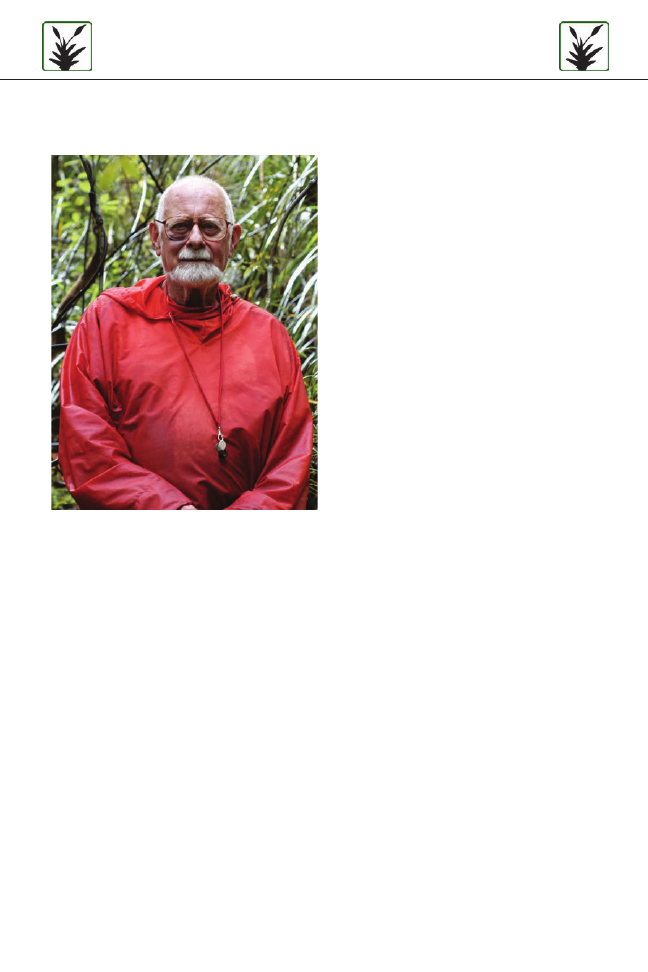
165
this colleague’s friend who was a student at NYU.
This NYU student had a friend in the entomology
department at Cornell. When they were visiting
this entomologist, he asked Rudy whether he
would like to study at Cornell. Rudy immediately
said “yes,” the entomologist had Rudy complete
all the paperwork, and he became a student there.
Cornell’s liberal arts college was very expensive but
the agricultural college was almost free, with no
tuition and only a nominal fee. That was how Rudy
got his education there! He finished his bachelor of
science degree in three years.
At Cornell, Rudy met his first wife, Olga, who was
born in New York City into a Serbian immigrant
family. They were married in 1943, by the mayor of
Ithaca. At that time in the United States, there was a
tradition that the presider of the wedding ceremony
would ask the bride, “Do you accept and obey Mr.
so and so?” As the mayor knew Rudy’s character,
he asked Olga whether she wanted the word “obey”
used at the wedding ceremony. Olga replied “no.”
Yet, she “obeyed” Rudy throughout her entire life to
assist him in all aspects of his science, traveled all
over the world on collecting trips, and tended to all
of Rudy’s needs in his home office and laboratory.
Rudy certainly was a worldly figure in botany,
but his worldly character was manifested before
he became a botanist. He and Olga were both ex-
Catholics, and therefore were not married in a
Catholic church. Two experiences influenced his
departure from the church. One was that he saw
how in Spain the Catholic Church allied itself with
the fascist government. The other was that he saw
the church as being very intolerant. For example,
when he was between 11 and 13 years old, he had a
Jewish friend, but a young minister told him not to
play with any Jew. At Rudy and Olga’s wedding, the
best man was a Hindu.
In Cornell, Rudy was studying insect taxonomy,
but the department was oriented toward application
(insect control). In the 1940s, DDT was used to
control pests and house flies. He saw that 99%
of the houseflies were killed but 1% remained.
He suggested to the people who were studying
insect control that this surviving 1% would be a
big problem for the future. Thus, he saw chemical
control as no solution to the problem, and decided
not to pursue a career in that field.
At that time, bryology was a relatively small field.
Rudy thought that pursuing a discipline such as
In Memoriam
Rudolf Mathias Schuster
1921–2012
Rudolf M. Schuster, an eminent botanist,
hepaticologist, scholar, and world explorer, passed
away on Friday, November 16, 2012, in Stanwood,
Washington.
Dr. Schuster was born on April 8, one thousand
nine hundred twenty-one (as he would have
pronounced it in the German way) in Altmühldorf,
Bavaria, southern Germany. His father was Mathias
Schuster, a cabinet maker, and his mother was
Maria Schuster. He had a younger brother, by four
years, with whom he had a lot in common.
Rudy, as he was known to many in botanical
circles, came to the United States at the age of
nine and lived in New York City for his first 11
years in the United States. He finished high school
in 1939. It was the time of the Great Depression,
which helped shape Rudy’s frugal lifestyle. For his
college education, Rudy first attended City College
of New York. One day while he was washing
chemical vials with a colleague who had attended
New York University (NYU), he was introduced to
ANNOUNCEMENTS

166
Plant Science Bulletin 59(4) 2013
bryology, a pure science that nobody would care
much about, would allow him complete freedom
to do whatever he wanted (which was absolutely
important for a man like Rudy!). His interest in
bryology actually started before his years at Cornell.
As a teenager in New York City, he often visited the
New York Botanical Garden, which had an exhibit
of bryophytes. This experience obviously had an
influence on him. He started collecting bryophytes
at the age of 18 or 19, around the time he finished
high school and started college. His love of nature,
however, went back much further. One of his
earliest memories was chasing butterflies on a walk
with his father when the family lived in Germany.
While Rudy was a student, Olga was working at
Cornell University Press. One time, she told her
boss that her husband was going to publish books
on hepatics; he did not think she was serious.
Later, when they both went back to visit Cornell,
they saw Olga’s former boss and told him that
Columbia University Press had published two
of Rudy’s volumes on North American hepatics
and hornworts—a statement that elicited a funny
expression from him. Those books, of course,
became affectionately known as “the Big Green”
due to their large size and eventually became a
multi-volume treatise.
1,2
The spores of the Big
Green obviously germinated during the time of
Rudy’s Cornell years as an entomology undergrad,
and this can also be seen from Rudy’s first major
publication, “The Ecology and Distribution of
Hepaticae in Central and Western New York,”
which was published in The American Midland
Naturalist in 1949 (42: 513–712).
Rudy’s study of entomology continued after
Cornell, into graduate school. Surprisingly to many
in the bryology world, Rudy actually obtained
his PhD in entomology from the University of
Minnesota in 1948. However, he had assistantships
in botany and was a frequent visitor to the
University herbarium.
3
His study of the hepatics
of Minnesota and adjacent regions in those years
resulted in the three papers
4–6
that greatly enhanced
our understanding of the hepatic flora of the Upper
Mississippi valley.
3
After leaving the University of Minnesota,
Rudy traveled down the river to the University
of Mississippi and worked there as an assistant
professor. It was there, in 1950, that he received a
National Science Foundation grant to write the Big
Green. After three years in Mississippi, he took a
visiting assistant professorship at Duke University.
Louis Anderson, a renowned bryologist at Duke
and a Mississippi native, once visited Rudy and
told him that he should go somewhere else for a
better career. He then worked to get Rudy out of
Mississippi. However, with Anderson as a moss
expert and H. L. Blomquist as a liverwort expert on
Duke’s faculty, there was not a permanent position
there for Rudy. Thus, Rudy went to the University
of Michigan and was there for a year as an assistant
professor.
In 1957, when an opportunity came up at the
University of Massachusetts, Amherst, Rudy
moved there. He was first appointed as an associate
professor and a year later was promoted to a full
professor. He remained at UMass until his retirement
in 1983. Rudy and Olga loved picturesque western
Massachusetts, and the rich bryophyte flora there
made their life and work even more enjoyable. In
addition to their home in Hadley, a small town next
to Amherst, they also owned a piece of property (60
acres) in Conway, a low mountain town northwest
of Hadley. Rudy, Olga, and their two daughters
spent a lot of weekends in the wood cabin that
Rudy built himself on the Conway property. The
hepatic diversity on that property was, of course,
thoroughly surveyed by Rudy and often mentioned
in the Big Green. Back in Hadley, the garden
surrounding their house was filled with plants
Rudy brought home from his collecting trips in
the southern Appalachian Mountains. The physical
labor required to maintain the garden and the
Conway property obviously helped to keep Rudy’s
sanity after long hours of work in the basement
laboratory, which later officially acquired the
name of Hadley Cryptogamic Laboratory. In their
later years, Rudy and Olga also owned a home in
Arizona, and the two would migrate to the south
in winter and come back to the north in summer.
In the winter of 2004, however, the two stayed in
Massachusetts, and Olga passed away on February
23, 2005, in their home. After Olga passed away,
Rudy was lonely but continued to work on the last
major project in his life, the Austral Hepaticae. On
November 16, 2005, he married his second wife,
Marlene, who became Rudy’s new companion and
assistant in all of his work and travel.
Rudy’s major contribution to botany and
hepaticology lies in the astounding new diversity
of liverworts he added to our knowledge. Mostly
by himself or through collaboration with a small
number of colleagues, he described 463 species,
83 genera, and 15 families new to science. These
taxa account for 6%, 22%, and 18%, respectively,

167
Plant Science Bulletin 59(4) 2013
of the taxa at these ranks for liverworts. It is
difficult to name another contemporary botanist
who discovered so much new diversity of a major
clade of land plants. These discoveries were made
in his land-combing floristic surveys of hepatics in
eastern North America, Greenland, New Zealand,
and other parts of the world (in total he did
fieldwork in over 25 countries!). Over the decades,
Rudy collected in the order of 50,000 specimens.
This extremely valuable and now historical
collection resides at the Field Museum of Natural
History, Chicago, along with his microscopic slide
collection. Much of his extensive library was also
kindly donated to the Museum by his wife, Marlene
Schuster.
Two significant and ever-lasting results of his
surveys were published in two multi-volume works:
The Hepaticae and Anthocerotae of North America,
East of the Hundredth Meridian (the Big Green),
consisting of six volumes, and Austral Hepaticae,
consisting of two volumes. These floras are not mere
conventional compilations of taxonomic diversity;
they are encyclopedic treatments of liverworts
and hornworts as well as their biology. The first
volume of the Big Green in particular contains
rich information about the history of studies of
hepatics (which historically included hornworts!),
morphology, anatomy, development, and cytology
of liverworts. Naturally, Rudy published his own
system of classification of liverworts. Blocks of
families that appeared in his system corresponded
to clades and grades identified in later molecular
systematic analyses, which reflected the power of
his sharp insights and critical thinking based on
both field observation and laboratory examination
under microscopes. It is noteworthy that Rudy
was also an excellent illustrator, having drawn and
inked the majority of the illustrations in his books
and papers. He spent countless hours painstakingly
preparing these fine illustrative plates—totaling
over 1000 throughout his career. These plates always
received outstanding comments in book reviews,
and were extraordinarily precise and detailed.
At the time of publication (before cladistics and
molecular systematics), his classification system
represented a truly outstanding summary of the
knowledge of liverworts.
Rudy’s contributions to botany went beyond
hepatics. He was one of the first botanists to
recognize the importance of Wallace’s Line in
plant biogeography, separating Australia of
Gondwanaland from Southeast Asia of Laurasia.
7
He astutely recognized that the rich diversity of
angiosperms and other plant groups in the general
area between Assam and Fiji and between Japan
and Tasmania–New Zealand was not necessarily
the result of the origin of angiosperms or any
other group in the area, but to the juxtaposition
of elements of two rich biotas—Laurasia-derived
and Gondwanaland-derived.
8
This historical
biogeographic analysis directly resulted in the
rejection of Australasia as the cradle of the
angiosperm hypothesis proposed by A. C. Smith
and A. Takhtajan. Moreover, Rudy also provided
botanical evidence supporting the continental drift
theory at a time when it was still controversial.
8,9
Rudy is one of the foremost classical scholars
of our time in botany. His rigorous scholarship is
clearly reflected in his books and literally hundreds
of published papers. One of the best examples
demonstrating his relentless pursuit of the truth is his
tracing of ideas that contributed to the recognition
of hornworts as a distinct lineage of bryophytes
that is at the level of liverworts or mosses. Until the
late 1800s, hornworts were always thought to be
included in hepatics. Howe
10
is usually credited with
formally elevating the Anthocerotales to the rank of
a separate class (Anthocerotes), together with the
class Hepaticae. In the first volume of the Big Green
(p. 369), Rudy provided a long footnote discussing
the ideas of three bryologists, Janczewski,
11
Hy,
12
and Underwood,
13
that eventually resulted in
Howe’s nomenclatural treatment. These authors
emphasized several features that set hornworts apart
from liverworts and thus warranted their placement
in a separate higher-rank taxon equivalent to
liverworts and mosses: the embedded archegonium
(with no differentiated archegonial wall), the
single chloroplast in the cell, and the basipetal
development of the sporangium with basipetal
sequence in spore formation. These features have
figured prominently in recent discussion on the
phylogenetic position of hornworts.
Rudy was a generous and hospitable man, even
though he had a strong personality. His Bavarian
stubbornness and diligence undoubtedly played
a role in shaping his career of studying one of the
most recalcitrant survivors of plants on earth. He
will be greatly missed by botanists all over the
world.

168
Plant Science Bulletin 59(4) 2013
Personalia
Claire Hemingway
Claire Hemingway, the Botanical Society of
America’s first Education Director, has taken a
new position as Science Advisor with the Division
of Environmental Biology at the National Science
Foundation (NSF). She says that she’s looking
forward to advancing science and broader impacts.
Claire was a BSA staff member for the past nine
years, first as Managing Editor of the American
Journal of Botany and more recently as Education
Director working on behalf of the Society’s
education and outreach mission. She was principal
investigator of two successful NSF-funded education
projects for the Society and was instrumental in
directing the evolution of PlantingScience from
its origin as SciPi and SIP
3
to what it is today—a
world-class team including professional scientists
from the BSA, American Society of Plant Biologists,
and Biological Sciences Curriculum Study and
outstanding middle and high school teachers from
throughout the country and around the world.
Being able to ride herd on a group of independently
minded academics while bridging the gap between
schools and professional scientists is a testament to
her leadership and inspirational skills. Through her
efforts, the participants in the summer institutes
for teachers and the Master Plant Science Mentors
have blossomed into a model of synergistic positive
impact on student learning about plants. Before
leaving she oversaw revision of a new NSF proposal,
which will be submitted in December to support
PlantingScience into the future.
We wish her the best in her new position at NSF.
Literature Cited
1. Schuster, R. M. 1966. The Hepaticae and
Anthocerotae of North America, Vol. I. Columbia
University Press, New York, New York, USA.
2. Schuster, R. M. 1969. The Hepaticae and
Anthocerotae of North America, Vol. II Columbia
University Press, New York, New York, USA.
3. Frenkel, A. W., and E. C. Abbe. 1988. Rudolf
Schuster’s contribution to Minnesota Botany.
Beiheft zur Nova Hedwigia 90: 25–26.
4. Schuster, R. M. 1953 Boreal Hepaticae, a manual
of the liverworts of Minnesota and adjacent
regions. Am. Midl. Nat. 49: 257–684.
5. Schuster, R. M. 1957. Boreal Hepaticae, a
manual of the liverworts of Minnesota and
adjacent regions. II. Ecology. Am. Midl. Nat. 57:
203–299.
6. Schuster, R. M. 1958. Boreal Hepaticae, a
manual of the liverworts of Minnesota and
adjacent regions. III. Phytogeography. Am.
Midl. Nat. 59: 257–332.
7. Cronquist, A. 1988. Schuster and Wallace’s Line.
Beiheft zur Nova Hedwigia 90: 39–40.
8. Schuster, R. M. 1972. Continental movements,
“Wallace’s line” and Indomalayan-Australasian
dispersal of land plants—some eclectic
concepts. Bot. Rev. 38: 3–86.
9. Schuster, R. M. 1969. Problems of antipodal
distribution in lower land plants. Taxon 18: 46–91.
10. Howe, M. A. 1899. The Hepaticae and
Anthocerotes of California. Memoirs of the
Torrey Botanical Club 7: 1–208, pls. 88–122.
11.
Janczewski, E. 1872. Vergleichende
Untersuchungen ueber die Entwicklungsgeschichte
des Archegoniums. Botanische Zeitung 30: 377–394,
401–420, 440–443.
12. Hy, M. 1884. Recherches sur l’archégone et le
développement du fruit des Muscinées. Annales
des sciences naturelles, Série 6 Botanique 18:
105–206, pls. 109–114.
13. Underwood, L. M. 1894. The Evolution of the
Hepaticae. Botanical Gazette 19: 347–361.
-Yin-Long Qiu, Department of Ecology and Evolu-
tionary Biology, University of Michigan, Ann Arbor,
Michigan, USA; and Matt von Konrat and John J.
Engel, The Field Museum, Chicago, Illinois, USA.
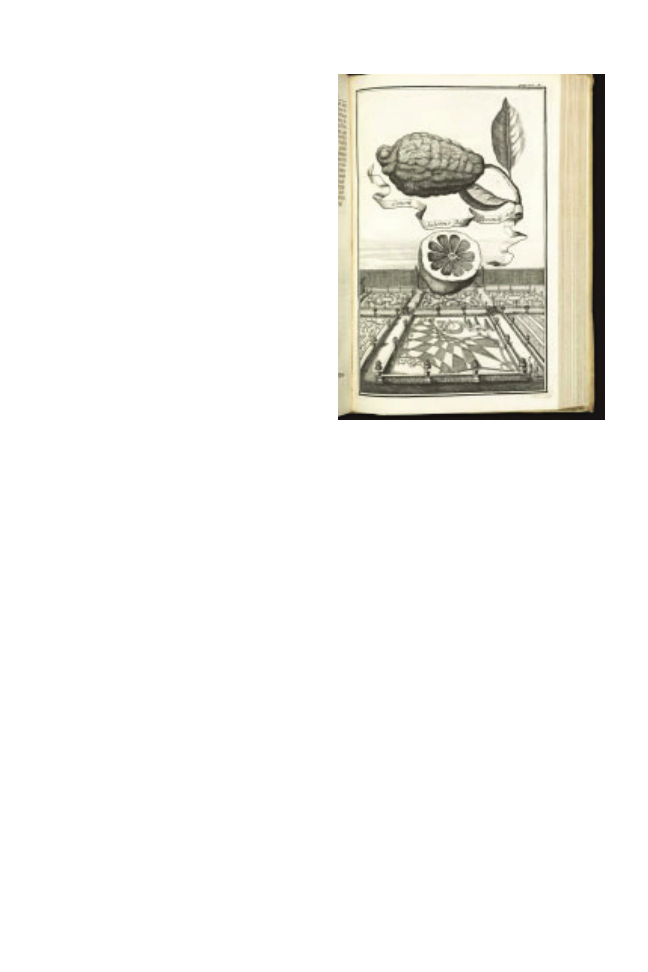
169
Plant Science Bulletin 59(4) 2013
GETTY RESEARCH INSTITUTE
ANNOUNCES
GIFT OF RARE BOTANICAL BOOKS
The 41 Books in the Tania Norris
Collection of Rare Botanical
Books Span the 16th to 19th
Centuries
LOS ANGELES—The Getty Research Institute
(GRI) announced today the acquisition of The
Tania Norris Collection of Rare Botanical Books, a
gift from collector Tania Norris. Assembled over
the last 30 years by Ms. Norris through individual
acquisitions from booksellers in the U.S., Europe,
and Australia, the collection consists of 41 rare
books that provide unparalleled insight into the
contributions of natural science to visual culture in
Europe from the sixteenth through the nineteenth
centuries.
Highlights of the collection include Crispin
Van de Passe’s Hortus Floridus (1614), apparently
the first illustrated book to apply the microscopy
of magnifying lenses to botanical illustration;
and Johann Christoph Volkamer’s Nürnbergische
Hesperides (1708), documenting both the
introduction of Italian citrus culture to Germany,
and the revolution in urban planning that ensued
from the parks designed for their cultivation and
irrigation. Also found in the collection is a copy
of Maria Sibylla Merian’s Derde en laatste deel der
Rupsen Begin (1717), the first book to depict insect
metamorphosis, reputedly hand-colored by her
daughter.
“The Getty Research Institute is deeply honored to
receive the donation of the Tania Norris Collection
of Rare Botanical Books from one of the founding
members of our GRI Council. This gift promises to
open novel paths to explore the complex historical
intersections between science and art,” said Marcia
Reed chief curator at the Getty Research Institute.
“Tania’s passionate interests and her collecting
instincts have created a very generous gift which
has also served to raise the profile of an important
subject with strong relevance for researchers who
use our special collections.”
David Brafman, curator of rare books at the GRI,
said, “The Norris Collection offers inestimable
rewards for scholars researching global botanical
trade and the ensuing stimulus of cultural exchange
to the trend of collecting curiosities spawned in
Renaissance and Baroque European culture. Other
books in the collection document the codependent
progress of technologies in the history of medicine,
pharmacology, and the color and textile industries
from the sixteenth to nineteenth centuries. No
less important are the opportunities to study the
complex artistic relationship between physiognomy
and ‘naturalism’ in visual representation, as well as
developments in urban planning and landscape
architecture. Ms. Norris’ generous donation
enhances significantly GRI’s existing collections in
such subjects and promises to transform the way
art historians examine the past in the future.”
In particular, the unique hand-colored copy of
Maria Sibylla Merian’s Der Rupsen Begin (Birth
of the Butterfly) from the Norris Collection will
find a companion in the GRI vaults: Merian’s
stunning Metamorphosis of the Insects of Surinam
(1719), the self-published book that documented
the watercolors, drawings, and scientific studies
she executed and conducted while exploring
the wildlife of the South American jungles. The
Limon Salerno da Genova (detail) from Nürn-
bergische Hesperides, Nuremberg, 1708. Johann
Christoph Volkamer. The Getty Research Institute,
2885-927. Donated by Tania Norris

170
Plant Science Bulletin 59(4) 2013
GRI copy was featured prominently in the Getty
Museum’s exhibition, “Merian and Daughters,”
which celebrated the extraordinary pioneering
contributions of the artist-naturalist, the first
European woman to travel to America expressly for
artistic purposes.
The Norris Collection will also prove an
invaluable complement for research in landscape
and still-life painting, as well as mention the insights
it will provide to conservators and conservation
scientists about recipes and global trade in color
pigments and other preparations in the decorative
arts.
In addition to being a founding member of
the Getty Research Institute Collections Council,
Ms. Norris also serves on the J. Paul Getty
Museum Disegno Drawing Council and Paintings
Conservation Council.
“It was one of the proudest moments of my life
when the Getty Research Institute accepted my
books for their library. I never collected expecting
anyone else to think my books of interest,” said Ms.
Norris. “But now at the GRI, anyone can view them;
some have been or will soon be in exhibitions and
programs. More importantly, they will be preserved
for generations to come.”
“You don’t need much money, just passion to
collect and you just never know what treasures you
may have,” she added.
Much of the collection has been on deposit at
the GRI and available to researchers; the remaining
materials will be cataloged and available by the
end of year. For more information about The
Tania Norris Collection of Rare Botanical Books,
visit: www.getty.edu/research/special_collections/
notable/norris.html.
Additional information is available at
www.getty.edu.
MISSOURI BOTANICAL
GARDEN ANNOUNCES GRANT
AWARD
Project Aims to Improve Access
to Digital Texts through Online
Gaming
(ST. LOUIS)—The Missouri Botanical Garden
was recently awarded a $449,641 grant by the
Institute of Museum and Library Services (IMLS)
to test new means of using crowdsourcing and
gaming to support the enhancement of texts from
the Biodiversity Heritage Library (BHL). Grant
funding begins in December 2013 and ends in
December 2015. The Garden will partner with
Harvard University, Cornell University and the
New York Botanical Garden on the project.
The BHL is an international consortium of
the leading natural history libraries that have
collaborated to digitize records of the world’s
biological diversity. It is the single largest open-
licensed source of biodiversity literature in the
world with more than 40 million pages of scanned
texts available online at www.biodiversitylibrary.
org.
Digital libraries such as the BHL are hampered
by poor output from Optical Character Recognition
(OCR) software that makes it difficult for users
to easily search texts. The BHL contains a variety
of literature including books and journals dating
back to the 1400s. Historic literature is particularly
problematic for OCR software because of the
variation in fonts, typesetting and layouts. There is
currently no OCR engine to accurately recognize
most types from the 15th to mid-19th centuries
included in the collection. BHL’s horticultural
catalogs and field notebooks also present challenges
to OCR software because of their multi-columned
layouts and use of handwritten notes. Garden
staffers saw a pressing need to identify possible
solutions for this problem.
The project, “Purposeful Gaming and BHL,” will
demonstrate whether or not online games are a
successful tool for analyzing and improving digital
outputs. Users will be presented words that are
difficult for software to recognize as tasks in a game.
“Digital gaming as entertainment has been
around for several decades but only recently has
it been used for more practical purposes,” said
Trish Rose-Sandler, data project coordinator in the
Center for Biodiversity Informatics at the Missouri
Botanical Garden and data analyst for the BHL.

171
Plant Science Bulletin 59(4) 2013
“Combined with crowdsourcing, it can be a very
efficient way to harness large numbers of users to
complete a task.”
Benefits from the project include both improved
access to content in the largest open-access
repository in biodiversity, the BHL, and the
demonstration of novel and more cost-effective
approaches to generating searchable texts within
the broader digital library community.
Teams from all four institutions will work
with a professional software developer to design
the gaming application needed for the project.
Rose-Sandler will be responsible for the overall
coordination of the project.
Plant Health Scientists
Reiterate Support of
Biotechnology on
World Food Day
October 18, 2013 (St. Paul, MN)—Given the
continuing debate about biotechnology, the
Council of the American Phytopathological Society
(APS) refined its position on the topic this week,
as three pioneers of agricultural biotechnology
received the World Food Prize. APS, the world’s
largest organization of plant health scientists,
represents nearly 5000 members in 90 different
countries. Citing enormous potential benefits
for management of plant diseases offered by
this technology, APS reiterated its support and
opposed mandatory labeling of food derived from
genetically modified (GM) plants.
“Biotechnology today is a valuable tool for
improving plant health, food and feed safety, and
sustainable gains in plant productivity,” stated APS
President George Abawi. “As has been discussed
this week during the Borlaug Summit and the
World Food Prize, biotechnology will continue to
be an extremely important part of the toolbox for
managing plant health.”
While strongly supporting transparent science-
based regulation of agricultural products, APS
has long opposed regulating food, feed, and fiber
products solely on the basis of the particular
technology used to create these products.
“Current scientific evidence supports the
conclusion that GM plants pose no greater safety
risk than traditionally bred plants. Labeling GM
could be very confusing to consumers,” suggested
Abawi, “and could reduce the availability and use
of this technology for the management of plant
diseases.”
For a copy of the complete APS Position
Statement on the Compulsory Labeling of
Plants and Plant Products Derived from
Biotechnology, visit www.apsnet.org/members/
outreach/ppb/positionstatements/Pages/
BiotechnologyPositionStatement.aspx.
The Second International
Conference on Duckweed
Research and Applications
Rutgers, the State University of
New Jersey, USA
August 21–24, 2013
Professor Dr. Eric Lam (Rutgers University and
Conference Chair) and PD Dr. Klaus-J. Appenroth
(University of Jena and Head of the International
Duckweed Steering Committee) report about the
meeting.
Why was a meeting organized for the relatively
small community of duckweed researchers and
developers?
The international duckweed community
organized a meeting because the members strongly
feel that this family of plants has a great potential
for practical applications as well as basic research.
There is a very good chance to use duckweed for
cleaning wastewater, as has been demonstrated in
the past. Also, several species of duckweed have been
reported to be the fastest-growing angiosperms
and they can be grown in places that cannot be
used for agriculture. The biomass can be used for
producing energy—via starch fermentation, biogas
production, or by other conversion methods. Thus,
duckweed can help solve urgent problems facing
mankind: availability of clean water and sustainable
energy production.
What are the highlights of results presented at
this meeting?
A key development for basic research involving
duckweed will be the availability of genomic
tools. Some important progress in this regard is
several reports in the Conference that described
sequencing and transcriptome studies that have
been submitted for publication or are nearing

172
Plant Science Bulletin 59(4) 2013
completion. The genomic sequence of clone 7498
of Spirodela polyrhiza was selected in 2009 for
sequencing by the DOE-JGI as a reference genome
for duckweed. This work is now in review for
publication and some of the characterization of
the assembled genome scaffolds was reported by
Wenq in Wang (group of Joachim Messing) from
Rutgers University (New Brunswick, New Jersey,
USA). Doug Bryant (from the Danforth Center
in St. Louis, Missouri, USA) also reported results
for 92 other clones of the same duckweed species
that are being completed soon by a consortium of
researchers from Rutgers and the Danforth Center.
By 2014, these efforts should make available
a rich set of genomic resource for the duckweed
community that will enable many advanced
molecular approaches in this system. Almudena
Molla-Morales from the group of Robert
Martienssen (Cold Spring Harbor, New York,
USA) presented results about the genetic studies
for biofuel production using Lemna gibba. In
addition to reporting their progress in sequencing
a reference genome for L. gibba, she also presented
an update on their progress to optimize stable gene
transfer protocols in duckweed. The efficiency of
genetic transformation was enhanced from 10%
callus transformation (Yamamoto et al., 2001) to
40% and the time for selection and regeneration
was shortened from 7 to 5 weeks. This improvement
should overcome a key bottleneck for research
with duckweed in the near future, especially with
the wealth of genomic information resulting
from the various sequencing projects. In several
reports from Japan the first results concerning
the interaction of bacteria with the root system
of duckweed were presented. The reported results
now clearly demonstrated growth promotion and
metabolic enhancement of duckweed upon co-
culture with specific species of bacteria. In one
case, the signaling compound has been identified to
be a carbohydrate (Masaaki Morikawa, Hokkaido
University, Sapporo, Japan) and it can stimulate
growth of different duckweed species as well as
other model land plants. These exciting findings
suggest the first example of duckweed-related
research that may result in significant benefits to
traditional agriculture.
After the genome of S. polyrhiza is known, how
to proceed with research?
The completed sequences for multiple S.
polyrhiza strains should pave the way for some key
advances in duckweed research and applications.
These include the following areas: (1) Mapping
the sequence variation landscape in the duckweed
genome should facilitate better understanding
of the adaptation mechanisms for this family
of aquatic plants; (2) creating better molecular
techniques for rapid genotyping of closely related
strains and species of duckweed; (3) determining
the set of genes and enzymes present in the
three genomes of these plants will provide the
foundation for detailed analysis of its metabolic
pathways as well as their regulatory pathways
through enabling system biology approaches; (4)
a well-annotated reference genome will enable
rigorous transcriptomic approaches, such as RNA-
seq, for gene discovery and functional genomic
studies; (5) the genome sequence, together with a
transcriptome database, should provide immediate
access to various duckweed promoters and coding
sequences for basic research as well as commercial
applications.
Which types of practical application will be
most important in the next years?
Some of the key applications/products from
duckweed will be: (1) systematic deployment of the
duckweed platform to remediate wastewater from
municipal and agricultural sources; (2) reliable
production of feed and fuel products at different
scales (from tons to thousands of tons per year);
(3) development of duckweed-based biorefineries
that can maximize use of the biomass for various
renewable bioproducts such as bioplastics and
high-value oils.
What is it about social networking and
duckweed?
As a new technology that is seeking to develop
into a novel industry, it is essential at this juncture
that we promote the system’s unique qualities and
benefits to the public-at-large, as well as to unite
the nascent community’s efforts in raising funds to
support centralized, shared resources that will be
critical for accelerated and sustainable development
of research and applications. To help achieve these
goals, adopting modern social media tools and
channels as well as organizing the worldwide
duckweed community through the International
Duckweed Steering Committee are some of the
efforts that are beginning to be implemented.

173
Plant Science Bulletin 59(4) 2013
BSA Seeks Editor for
Plant Science Bulletin
Deadline for Nominations Extended
The Botanical Society of America (BSA) is soliciting nominations for the position of Editor of the
Plant Science Bulletin (PSB) to serve a five-year term, beginning January 2015. Both self-nominations and
nominations of others are welcomed.
This is a rare leadership opportunity to contribute to the Society and the continued evolution of the PSB.
We seek someone with the desire to pursue innovation and explore new ways to serve the Society.
Duties of the Editor include both aspirational responsibility (helping shape a strategic vision for the PSB
along with the PSB Editorial Committee and BSA Publications Committee) and operational responsibilities
(soliciting contributions, coordinating reviews, working with Society office staff to produce copy, and
recruiting new Editorial Committee members). Qualities of candidates should include a broad familiarity
with different botanical specializations and especially botanical education, excellent communication skills,
and a strong commitment to the PSB.
Review of nominations will begin March 1, 2014. For the first stage of the review process, please submit
a brief letter of nomination and a detailed vita of the nominated individual to Dr. Sean Graham, Search
Committee Chair at the following email address: swgraham@mail.ubc.ca.
The Committee may request additional information from candidates as the search process progresses. If
you have questions or comments, please contact Dr. Graham.
–PSB Editor Search Committee

174
Reports
Use of pollen to identify cattail
(Typha spp., Typhaceae) taxa in
Indiana
Joy E. Marburger
1
1
Great Lakes Research and Education Cen-
ter, Indiana Dunes National Lakeshore, 1100
North Mineral Springs Road, Porter Indiana
46304
Author for correspondence (
joy_marburg-
er@nps.gov)
10.3732/psb.1300003
Submitted 9 May, 2013.
Accepted 9 September, 2013.
Acknowledgments: I wish to thank John Ervin,
formerly with the Indiana Department of Natural
Resources State Nature Preserves, and National
Park Service volunteers Joel Cook, Alan Culbertson,
Emma Dlutkowski, David Hamilla, and John
Wasse, for their assistance in pollen collection and
evaluation.
ABSTRACT
Cattail (Typha spp.) hybridization in the U.S.
has resulted in their large-scale proliferation in
wetlands. Even though recent DNA fingerprinting
methods have been developed to identify the
taxa, the cost and time to identify them using
microsatellite analysis has restricted widespread
application of the technique. Pollen morphology
can be used as a tool to identify cattail hybrids
and the putative parents since the pollen forms
are distinct for the species and hybrids. Monads
are singular pollen shed during anthesis by T.
angustifolia; T. latifolia sheds pollen in tetrads,
which are units of four pollen.
Pollen from a hybrid plant can also have
combinations of dyads and triads, in addition
to monads and tetrads. This paper describes
a microscopic technique based on presence or
absence of various pollen types in each of 70 plants
sampled in northern Indiana. Only one plant
(1.4%) had typical T. latifolia tetrad pollen. Typha
angustifolia monad pollen type was much more
prevalent, representing 34.3% of the samples. Mixed
pollen types predominated, occurring in 64.3% of
the samples. This cost-effective method could be
used by restoration managers to determine if Typha
populations contain native T. latifolia, which is at
risk of being extirpated due to hybridization.
Keywords: Typha latifolia, T. angustifolia, T. ×glauca,
cattail, hybrids, pollen
INTRODUCTION
Cattails (Typha spp.) are reed-like wetland
graminoids that have undergone a massive invasion
of North American wetlands over the past 80 years.
Historically, cattails coexisted with other native
wetland species, but recently have begun to form
aggressive monocultures, with severe impacts to
biodiversity, particularly in the Great Lakes region.
Ecologists have hypothesized that T. angustifolia L.
was introduced from Europe along the east coast
in the mid-1800s (
Galatowitsch et al., 1999; Grace
and Harrison, 1986).
The superior competitive
ability of Typha in North American wetlands has
been attributed to hybridization between T. latifolia
L. and T. angustifolia, with resulting plants showing
hybrid vigor (Smith, 1967; Stuckey and Salamon,
1987). Typha hybrids in the Upper Midwest have
developed from interbreeding of Typha latifolia,
broad-leaf cattail, and Typha angustifolia, narrow-
leaf cattail, as indicated by molecular genetic
analysis (Marburger et al., 2005; Travis et al., 2010,
2011) and evidence of synchronous flowering of the
two species (Ball and Freeland, 2013). The hybrid,
referred to as T. ×glauca Godr., is highly variable
in its morphology depending on its location, and
thus difficult to identify. Its invasive properties
stem from its capacity for rapid clonal spread and
biomass production, which allows it to readily
supplant other native wetland species. Genetic
analyses have so far identified invasive stands of T.
×glauca in at least six Great Lakes National Parks
(Travis et al., 2010 and unpublished data), which
has raised serious resource management concerns
among wetland managers whose goal is to preserve
native plant biodiversity.
Uncertainties exist in identifying Typha species
and hybrids based on gross morphological features,
such as leaf width, gap between male and female
inflorescences, plant height, and stem diameter
(Snow et al., 2010). However, pollen morphology
has been identified as a tool to identify cattail hybrids
and the putative parents (Smith, 1967; Dugle and
Copps, 1972; Finkelstein, 2003). Although highly
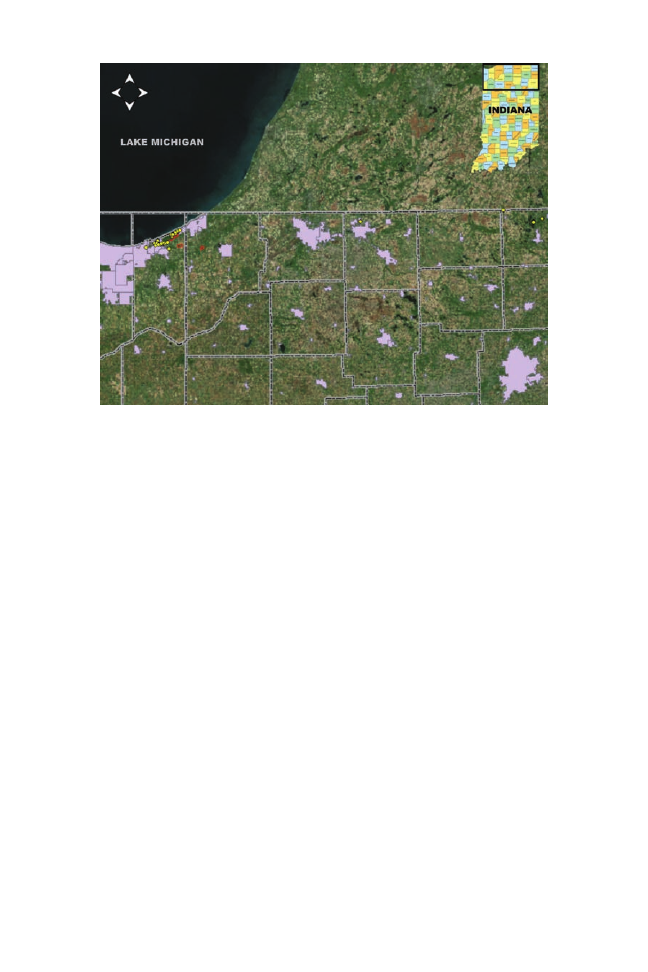
175
Plant Science Bulletin 59(4) 2013
Indiana Dunes National Lakeshore (IDNL), other
areas along roads near the national park in Porter
County, two sites in Elkhart County, and sites in
Lime Lake and Pokagon State Park. The latter two
are part of the Indiana Department of Natural
Resources State Nature Preserves. Collection sites
in IDNL were located in the Cowles Bog Unit and
in the Great Marsh Restoration Area near the town
of Beverly Shores. Collections were done from June
13 to 29 in 2008, 2009, and 2010.
Pollen from individual plants was collected
during anthesis. Pollen was shaken from male
inflorescences into plastic Ziploc bags labeled by
collector, GPS coordinates, site, and date. Care
was taken to prevent any cross-contamination in
collecting pollen from one plant to another. Bags
were stored in a cooler and transported to a –20°C
freezer until analysis could be conducted. Pollen
from each bag was removed using the tip of a small
paint brush and placed on a microscope slide. The
acetocarmine pollen staining method was used
(Ruzin, 1999). A drop of 1% acetocarmine solution
was placed on the pollen, which was then covered
with a glass coverslip. After 2-3 minutes in the
stain the pollen grain cytoplasm became pale pink,
and the nucleus became a darker pink. Pollen was
evaluated using 4X, 10X, and 40X power with a
Figure 1. Map showing Typha pollen collection sites (yellow points) in northern Indiana counties
(Porter, Elkhart, and Steuben; map insert). Light purple polygons are urban areas.
specific, the use of molecular analyses based on
microsatellite signatures to identify cattail taxa is
somewhat costly and time consuming. Therefore,
simple and inexpensive methods are needed to
assist managers in identifying whether hybrids,
the invasive T. angustifolia, or the native T. latifolia
are present in a population. Smith (1967) and
Finkelstein (2003) indicated that pollen grains
of T. latifolia occur in tetrads, while those of T.
angustifolia occur as monads (Fig. 2 a, d). They
noted that hybrids show a combination of these as
well as other types including dyads, triads, tetrads,
and abnormal tetrads (Fig. 2 b, c, e, f, g, h). Here
I describe a simple method to identify the species
and hybrids based on a rapid assessment of mature
pollen grains at anthesis.
METHODS
A scope of procedure (SOP) for pollen collection
was developed through consultation with the USGS
National Wetlands Research Center in Lafayette,
Louisiana (B. Middleton, USGS National Wetlands
Research Center, personal communication). With
the assistance of volunteers, I collected pollen
from 70 different plants in wetlands in Porter,
Elkhart, and Steuben counties of Indiana (Fig.
1; latitude= 41.61 to 41.72; longitude = –84.90 to
–87.15 decimal degrees). Sites were located in
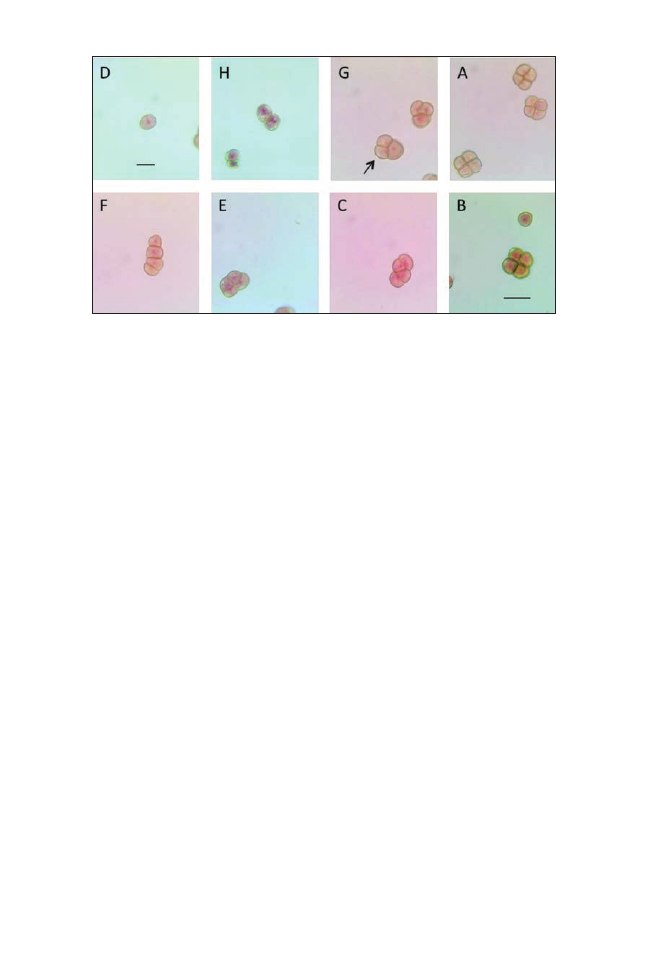
176
Plant Science Bulletin 59(4) 2013
compound light microscope. The pollen dispersed
when the coverslip was placed on the sample. A
digital camera attached to a compound microscope
was used to photograph the pollen (Fig. 2, a-h).
Prior to pollen removal from each bag, the brush
was cleaned with 70% alcohol and distilled water
to prevent cross-contamination. Each sample was
analyzed three times to confirm the presence or
absence of pollen types. Three slides per samples
were evaluated using a light microscope at 400X
magnification for the presence of monad, dyad,
triad, abnormal tetrad, and normal tetrad pollen.
Presence (1) or absence (0) of the pollen types
was recorded during visual scanning of each slide.
Photographs were taken with a digital camera
mounted on the microscope. Final images were
modified by lightening them using Microsoft™
Powerpoint Picture Tools Corrections. Descriptive
statistical analysis (SAS version 9.3.1, 2011) was
conducted to determine the distribution of the
various pollen combinations per sample.
RESULTS AND DISCUSSION
Tables 1 and Figure 3 show the results of the 70
cattail plants evaluated for presence or absence of
the various pollen types. A binary code was used
to show presence (1) or absence (0) of the various
pollen types in a sample, rather than counting
the numbers of each type, to facilitate use of the
method by resource managers conducting wetland
restoration. The sequence of pollen distribution
described for each sample was monad, dyad,
triad, tetrad, and abnormal tetrads. Several types
of abnormal tetrads were observed: linear and
butterfly shaped (Fig. 2, e-g). Hybrids included
any mixtures of pollen type from a single plant
(Fig. 2, a-h). Note that only one plant (1.4% of
samples) had typical T. latifolia tetrad pollen. Typha
angustifolia pollen type (monad only) was much
more prevalent, representing 34.3% of the samples.
These could also reflect backcrossed generations to
T. angustifolia, but previous work using molecular
methods indicated that plants in IDNL (Travis et
al., 2010) were first-generation hybrids. Hybrid
pollen types occurred in 64.3% of the samples. Two
samples (2.9%) had both normal and abnormal
tetrads in each sample, which were included in the
hybrid category to avoid labeling them as pure T.
latifolia, identified here as having normal tetrads
only.
Pollen morphological analysis may be useful
for determining cattail taxa in a site undergoing
restoration, since T. latifolia is becoming rarer due
to hybridization and dominance of hybrid taxa
in the Midwest. Both molecular identification
(Travis et al., 2010) and pollen analysis (Marburger,
unpublished data) at IDNL, particularly in the
Cowles Bog Wetland Complex, support the
evidence that first-generation hybrid cattail was
the dominant taxon at this site in 2008 when pollen
was first sampled. This information was conveyed
to managers who then developed a plan to remove
the cattail from the bog using glyphosate herbicide
and an overland vehicle that applied the herbicide
to the site in 2010. Restoration currently consists
of herbicide suppression of any new cattail plants
emerging from seed or rhizomes, reliance on the
native plant seed bank, and intensive planting of
species such as Carex spp. that do not persist in the
seed bank, as well as planting rare species.
Figure 2. Typha pollen types: A = monad; B = dyad; C = triad (arrow); D = tetrad; E, F, G = abnormal
Tetrad; H = hybrid sample with both monad and tetrad pollen. Bar in A = 25 µm; bar in H = 40 µm.

177
Plant Science Bulletin 59(4) 2013
Pollen analysis using a compound microscope
is a simple and cost-effective method that can be
done quickly to evaluate the presence of cattail
hybrids or parent species. DNA microsatellite
preparation and analysis cost approximately $20
per sample, with existing equipment and excluding
staff training (S. Travis, personal communication).
Pollen analysis costs would be approximately $1.00
a sample, excluding a one-time purchase of a
compound microscope and staff training. Thus the
cost savings would be 20 times less using the pollen
analysis method. A field microscope kit is being
developed to evaluate cattail taxa on site during
the flowering period. This would reduce the time
necessary to process samples in the laboratory and
hasten a decision to remove cattail populations for
restoration purposes.
LITERATURE CITED
Ball, D. and J.R. Freeland. 2013. Synchronous
flowering times and asymmetrical hybridization
in Typha latifolia and T. angustifolia in
northeastern North America. Aquatic Botany
104:224-227.
Dugle, J.R. and T.P. Copps. 1972. Pollen
characteristics of Manitoba cattails. The
Canadian Field-Naturalist 86:33-40.
Finkelstein, S. 2003. Identifying pollen grains of
Typha latifolia, Typha angustifolia, and Typha ×
glauca. Canadian Journal of Botany 81:985-990.
Galatowitsch, S.M., N.O. Anderson, and P.A.
Ascher 1999. Invasiveness in wetland plants of
temperate North America: Wetlands 19:733-
755.
Grace, J.B. and J.S. Harrison. 1986. The biology
of Canadian weeds. 73. Typha latifolia L.,
Typha angustifolia L. and Typha
×
glauca Godr.
Canadian Journal of Plant Sciences 66:361-379.
Marburger, J., S. Travis, and S. Windels. 2005.
Cattail sleuths use forensic science to better
understand spread of an invasive species.
National Park Service Natural Resource Year
in Review – 2005, Department of Interior,
National Park Service, Denver, CO. 2 pp.
Ruzin, S.E. 1999. Plant microtechnique and
microscopy. Oxford University Press, Oxford,
New York. 322 p.
SAS (Statistical Analysis System). 2011. SAS
Institute Inc., SAS® 9.3 Second Edition. Cary,
NC.
Smith, S.G. 1967. Typha: its taxonomy and the
ecological significance of hybrids. Archiv für
Hydrobiologie Beihefte 27:129-138.
Snow, A. A., S. E. Travis, R. Wildová, T. Fér, P.
M. Sweeney, J. E. Marburger, S. Windels, B.
Kubátová, and D. E. Goldberg. 2010. Species-
specific SSR markers for studies of hybrid cattails
(Typha latifolia × T. angustifolia, Typhaceae) in
North America. American Journal of Botany
97:2061-2067.
Stuckey, R.L. and D.P. Salamon. 1987. Typha
angustifolia in North America: a foreigner
masquerading as a native (Abstract). American
Journal of Botany 74:757.
Travis, S.E., J.E. Marburger, S. Windels, and
B.Kubátová. 2010. Clonal diversity and
hybridization dynamics of invasive cattail
(Typhaceae) stands in the Great Lakes Region
of North America. Journal of Ecology 98:7-16.
Travis, S. E., J.E. Marburger, S. Windels, and B.
Kubátová. 2011. Clonal structure of invasive
cattail (Typhaceae) stands in the Upper
Midwest Region of North America. Wetlands
31:221-228.
Wilcox, D.A., S.I. Apfelbaum, and R.D. Hiebert.
1985. Cattail invasion of sedge meadows
following hydrologic disturbance in the Cowles
Bog Wetland Complex, Indiana Dunes National
Lakeshore. Wetlands 4:115-128.
Figure 3. Percentage of Typha pollen types (monad,
dyad, triad, tetrad, abnormal tetrad) from 70 plants.

178
Book Reviews
Developmental and Structural
Forensic Botany: A Practical Guide ...............................................................................178
Economic Botany
The Hunter-Gatherer Within: Health and the Natural Human Diet ................................179
Mycology
The Kingdom of Fungi ...................................................................................................180
Systematics
Manual of Montana Vascular Plants ...............................................................................181
Wildflowers & Grasses of Virginia’s Coastal Plain ........................................................181
Wildflowers of the Mountain West .................................................................................182
development and structural
Forensic Botany: A Practical Guide
David W. Hall and Jason H. Byrd (eds.)
2012. ISBN-13: 978-0-470-66123-9
Paperback, US$79.95. 195 pp.
Wiley-Blackwell, Hoboken, New Jersey, USA
This is not a “how to” guide for becoming a
forensic botanist, in part because there is no formal
certification and no standards for training or
expertise exist. It is, however, part of the Essentials
of Forensic Science series sponsored by the Forensic
Science Society, and it does provide an interesting
introduction to all phases of applying botanical
expertise to a crime scene. It is quickly apparent
that no one person will be competent to consult in
all relevant areas, but the editors brought together
experts in each area to provide an overview of how
knowledge in that area is useful and essential in an
investigation.
The first two chapters give a general overview of
basic botany and its application under a variety
of legal definitions. They, along with Chapter 4 on
“Expert Evidence,” provide essential background
for understanding the detailed explanations for
evidence collection and analysis presented in
Chapter 3. The next five chapters, which comprise
half the book, will be of most interest to teaching
botanists. Chapter 5 (“Use and Guidelines for Plant
DNA Analysis in Forensics”) is a general overview
of molecular biology techniques and presents
several case studies using different techniques.
Chapters 6, 7, and 8 focus on various applications
of anatomical data. In addition to a primer on
microscopy, Chapter 6 provides guidelines for
making reference collections and preparing and
documenting specimens. Chapter 7 details the
famous Lindbergh case, while Chapter 8 focuses on
palynology, pollen, and spores—presenting basic
palynology and collecting, storing, and preparing
samples, as well as several case studies. The focus of
Chapter 9 is algal evidence, and seven case studies
are presented. The final chapter contains nine case
studies that use botanical evidence to place people
or objects at the scene of a crime and six case
studies that use botanical evidence to determine
time of death.
Who will use this book? It’s too technical for a non-
majors botany elective, although a course of that
title would probably draw students. For that cohort,
I’d consider upgrading the exercises in Glenco
Science’s Forensic Botany Investigations (New York
Botanical Garden, 2007). I’m considering renaming
our Plant Anatomy course (which seldom “makes”
given the small number of biology students in our
department following the botany emphasis track)
to Forensic Botany and using this as the primary
text supplemented by a traditional plant anatomy
text. For the instructor, it provides plenty of ideas
that could be incorporated as individual activities
in a variety of botany or biology labs.
Literature Cited
New York Botanical Garden. 2007. Forensic
Botany Investigations. Glenco Science, McGraw-
Hill, Columbus, Ohio, USA.
–Marshall D. Sundberg, Department of Biology, Em-
poria State University, Emporia, Kansas, USA

179
Plant Science Bulletin 59(4) 2013
Economic Botany
The Hunter-Gatherer Within:
Health and the Natural Human Diet
Kerry G. Brock and George M. Diggs Jr.
2013. ISBN-13: 978-1889878-40-9
Paperback, US$19.95. xi + 260 pp.
Botanical Research Institute of Texas Press,
Fort Worth, Texas, USA
Put simply, this book is a must-take course for
anyone who eats. Having heard from my older
son about the concepts of the “caveman diet” (aka:
“natural” diet, ancestral diet, evolutionary diet,
paleo diet, Paleolithic diet, primal diet, Neanderthal
diet, anti-inflammatory diet, etc.) and having
read some of Mark Sisson’s work on the “Primal
Blueprint,” I basically had a good idea of what this
small, well-prepared volume would contain. But
I was ready to read and review the volume to see
how the information was presented and how it
compared to what I had already heard and read.
Wow, am I glad to have read this book! First, the
authors allude to the courses that they teach and the
material in the book, to which my reaction was: this
book is a course on the topic and each chapter is a
lecture. My bias as a retired professor who taught
for many years may get in the way of objectivity, but
I loved the presentation. There is an adage about
telling students what you are going to tell them,
then telling them, and then telling them what you
told them. Well, triple redundancy probably has
a place in education (as well as national security,
etc.), and this book does repeat a lot of information
(just as a professor would refer back to information
presented in previous lectures). Although, once in
a while, the redundancy may be more distracting
then useful, overall it is effective—especially in view
of how much fascinating information is provided.
Like good teachers, the authors include many
insets that provide “Overviews,” “Key Concepts,”
and 19 or so “Success Stories.” The latter describe
real people who have benefited from changing their
diets; these add a certain level “proof” that the
book’s basic message is on track. The readability of
the book is enhanced by numerous photographs
and diagrams, all of which are useful in making
each lecture—that is, chapter—work. Similarly, the
addition of one or more appropriate quotes at the
beginning of each chapter adds interest for readers.
The authors do an outstanding job of presenting
information for possible lay readers who may
have a limited or nonexistent science background.
They gently explain everything one needs to
know about nutritional factors including proteins,
carbohydrates, and lipids, and they do it in such a
way that it is not “obnoxious” for readers who do
have a science background. My wife, who is, like me,
a scientist, thought the book was fairly technical in
places for a lay reader, but not too much so. Finally,
there are short (or sometimes long) footnotes
providing additional detailed information that
enhance the book’s content without interrupting
the flow of the main text.
Enough about why this is an enjoyable book to
read (or an enjoyable course to take). What about
“the message”? As I mentioned at the start of this
review, I knew something about this type of diet
before picking up the book. But I was taken aback
by how well the authors develop the case against the
“standard American diet” and against conventional
wisdom in respect to what is good and what is
bad for us to eat. In fact, as a scientist, I cringed
at their rather scathing criticism of science and
scientists in Appendix 1 (“Why Do the Experts
Often Get It Wrong?”); however, I am prepared to
accept that the overall premise of this appendix is
sound and that some of the data presented both
support that premise and make me, as a scientist,
blush with a bit of shame. A list of the section titles
for this appendix may be enough to whet one’s
appetite to read the book: “Measuring the Wrong
Thing,” “Confounding Variables,” “Data Cleansings
Including the ‘File Drawer’ Problem,” “Small Study
Size,” “The Numbers Problem: Small Effect Sizes,”
“Juggling the Numbers,” “Cherry-Picking Data
and Other Intellectual Dishonesty,” “Being Paid To
Get It Wrong—Scientific Prostitutes and Conflicts
of Interest,” and “Bias for Other Reasons.” No
matter how a professional scientist might react to
this exposé, the main point—viz., that a healthy
dose of skepticism can be critically important—is
certainly a concept both scientists and lay readers
can embrace. And, one hopes no reader will
read Appendix 1 and believe that all research is
inaccurate, fatally flawed, and/or corrupted by
outside influences! After reading this book, I was
convinced that getting away from the standard
American diet is absolutely logical and, as the
authors point out, a relatively simple, “nothing to
lose” proposition. Cutting back on sugars, starches,
all forms of artificial sweeteners, and additives is
not new advice. The argument against eating gluten
even if you are not technically gluten-intolerant and
the logic behind eating more meat and animal fats

180
Plant Science Bulletin 59(4) 2013
is proffered by many “caveman diet” proponents,
but this wonderful little book/course builds the
case so well that I and my wife were convinced
that the standard American diet is not good and
have begun moving toward a more natural diet.
As a lover of pasta (etc., etc., etc.), my change of
heart comes only after a convincing and enjoyable
“course” contained in a great little book that is a
must-read for anyone who eats, that is, everyone.
–Russell L. Chapman, Professor Emeritus and
Founding Dean, School of the Coast and Environ-
ment, Louisiana State University, Baton Rouge,
Louisiana, USA
MYCOLOGY
The Kingdom of Fungi
Jens J. Petersen
2013. ISBN-13: 978-0-691-15754-2
Cloth, US$29.95. 265 pp.
Princeton University Press, Princeton, New
Jersey, USA
Faced with the alarming pace of environmental
destruction and the increasing disconnect between
science and the general public, a number of natural
scientists are directing their attention to the non-
specialist, making the case for the importance,
value, and beauty of the organisms they study. The
Kingdom of Fungi, a visually spectacular book by
Danish mycologist Jens Petersen, is an example
of this welcome trend. The book is quite sparing
with text—no more than a couple of sentences
per page on average—while giving center stage
to the author’s (and colleagues’) impressive color
photographs. By highlighting basic features of
fungal structure, development, and function, many
of these images distinguish themselves from those
chosen for mere aesthetic appeal by authors of large-
format nature books destined for the non-scientific
coffee table. The photos are so effective that even
the experienced mycologist will linger over them,
finding many that stimulate thinking about some
aspect of fungal biology and many more that would
be very useful in the classroom. As one would
expect, there are plenty of excellent images of fruit
bodies in their natural habitat, including quite a few
that the average mycologist is not likely to have seen
before. Particularly impressive here is the depth of
field achieved with close-up photography, and the
contrast compression that conserves detail even
where very white fruit bodies are shown against
very dark backgrounds. Also featured are a number
of excellent images of those less photogenic but all-
important fungal structures such as mycorrhizae,
hyphal cords, and rhizomorphs. There are
pedagogically useful diagrams where convergent
and divergent structures are mapped onto
biosystematic pie charts serving as highly pruned
phylogenetic trees. The diversity of lamellar (gill)
morphology is beautifully and usefully compared
among mushrooms, likewise the pore structures
found among polypores. Clouds of ejected spores
are shown hovering about several fruit bodies.
And great use is made of high-magnification
dissecting microscope images where, for example,
one can distinguish basidiospores and asci in
context on the surfaces of their respective fruit
bodies. Others show the surfaces of developing
fruit bodies with sufficient magnification to
reveal their fundamentally hyphal construction.
Compound microscope images are fewer but also
used effectively, for example, the micrographs of
the different kinds of “heterobasidia” that are so
challenging to prepare from their gelatinous fruit
bodies.
Only a couple of possible inaccuracies are apparent,
and they are minor. A transmission electron
microscopy (TEM) image purported to depict
“vacuoles” filled with enzymes for digesting food
seems instead to show vesicles of the Spitzenkörper
complex involved in wall synthesis at the hyphal
apex. In an image of the lichen Cladonia ramulosa,
structures located at the tips of podetia that are
identified as fruit bodies appear instead to be the
presumed gametangia (pycnidia/spermogonia).
While ostensibly addressing the uninitiated, the
sparse text is in fact fairly dense in information, and
the reader will need some basic understanding of
biology to fully make sense of it. At times the text
may presume much of the amateur audience; for
example, the term “agaric” is used from the outset
without explanation. In the absence of clarification,
even biology students will mistakenly assume that
“sexual spores” means gametes, and that “sterile
hyphae” must refer to those not contaminated
with bacteria. On the other hand, the text repeats
its explanation of the very basic terms “hyphae”
and “mycelium” on pages 6 and 12 in an apparent
oversight. There are some spelling mistakes (e.g.,
mosaik, significent, inclucing, chaterelle) that
the editors could have easily located with word
processing software.
Considering finally the modest price of $29.95

181
Plant Science Bulletin 59(4) 2013
in hardcover, it is not easy to see how any
mycologist, broadly interested botanist, naturalist,
or mushroom enthusiast could resist owning this
magnificently illustrated work.
–William B. Sanders, Department of Biological
Sciences, Florida Gulf Coast University, Fort Myers,
Florida, USA
Systematics
Manual of Montana Vascular
Plants
Peter Lesica
2012. ISBN-13: 978-1889878-39-3
Paperback, US$50.00. viii + 771 pp.
Botanical Research Institute of Texas Press,
Fort Worth, Texas, USA
The history of Montana floristics is given a chapter
of its own. The story begins with the Lewis & Clark
expedition, and “ends” with the present volume.
Properly, as Peter Lesica would be the first to
acknowledge, the next chapter really begins with
the publication of this book. Heretofore, there has
been nothing so detailed and extensive for the state.
Its predecessor was Robert Dorn’s Vascular Plants
of Montana (Dorn, 1984), which is still available as
a new copy (though no longer in print, I believe)
for $125–$537, with used copies a great deal less.
In that work, Dorn acknowledges the assistance of
Peter Lesica.
The present manual is a very different work, with full
keys, ample descriptions, a great many illustrations,
and a Montana distribution map for nearly every
recognized species. The range statements use the
official post office abbreviations for the states and
provinces of the United States and Canada; these
are given on p. 40, alphabetized by the abbreviation,
which is very helpful.
The arrangement of families is by the Cronquist
system, with some families reconfigured to
reflect modern phylogenetic thinking; hence,
Chenopodiaceae are merged with Amaranthaceae,
and traditional genera of Scrophulariaceae are
mostly segregated into Phrymaceae, Plantagin-
aceae, and Orobanchaceae, such that there are
now only four species of scrophs in the Montana
flora. It appears that some of the plates were
prepared before this drastic segregation occurred,
so that the fine drawing of Penstemon ellipticus
(Plantaginaceae, p. 438) ends up in Plate 81 (p. 454)
with members of the Orobanchaceae. It’s clearly
indicated on p. 438 where the figure is to be found,
so there’s no real harm done. The genera within
each family, and the species within each genus, are
given alphabetically—a most useful arrangement. I
tried some of the keys, and they worked.
The nomenclatural apparatus is minimized.
Synonyms appear to be given only in cases where
they have appeared in other recent treatments for
Montana. Therefore, the basionyms of binomials
with parenthetical authors are not routinely
given. When type specimens came originally from
today’s Montana, the author notes it—a welcome
nod to history. The author is entirely aware of
the taxonomic decisions taken in Flora of North
America, but has avoided the temptation of merely
copying that masterly work; his treatment of
Cirsium canovirens (p. 515) is an excellent example
of how close attention to local circumstances can
lend new insights.
The work ends with an ample index. The Literature
Cited is not given just before the index, as one
might expect, but occupies pp. 19–32. The entries
are alphabetical by author, but are preceded by a
number in parentheses, and it is these numbers
which are used throughout the book. This is a useful
device, not unique to this work, which deserves to
be more widely copied.
Literature Cited
Dorn, R. D. 1984. Vascular Plants of Montana.
Mountain West Publishing, Missoula, Montana,
USA.
–Neil A. Harriman, Biology Department, University
of Wisconsin–Oshkosh, Oshkosh, Wisconsin, USA
Wildflowers & Grasses of Virginia’s
Coastal Plain
Helen Hamilton and Gustavus Hall
2013. ISBN-13: 978-1-889878-41-6
Flex-binding, US$24.95. 276 pp.
Botanical Research Institute of Texas Press,
Fort Worth, Texas, USA
Wildflowers & Grasses of Virginia’s Coastal Plain
begins with the Acknowledgments, which are
more usually put at the end of a volume. It’s easy
to see why this arrangement was adopted, though,
because there is a formidable array of botanical and
editorial expertise at play here, and it shows. The
full-color photos and text are models of how books

182
Plant Science Bulletin 59(4) 2013
Wildflowers of the Mountain West
Richard M. Anderson, JayDee Gunnell, and
Jerry L. Goodspeed
2012. ISBN-13: 978-0-87421-895-4
Spiralbound, US$26.95. 302 pp.
University Press of Colorado, Boulder, Colo-
rado, USA
This is a guide to 130 of the most common
wildflowers in the Mountain West. Like most
guidebooks for novices, it is organized by flower
color. It includes the typical information for a
species, such as common name, habitat, elevation,
bloom time, distribution, and plant size. Although
the authors do not state this in the introduction, all
of the wildflowers covered are native plants. With
nonnative plants becoming an increasing problem,
this should be stated. The book presents pictures of
basic flower shapes that are too simplified. Although
it is admittedly challenging to communicate exactly
what a plant in the Compositae family is, they do
not shed any light on the basic flower structure of
a composite species. The reader is left not knowing
that there are composites with all disc flowers or
all ray flowers. It is not clear that each ray/disc is
actually a flower and hence the name “composite.”
Also overlooked is the difference between radial
and bilateral symmetry, a characteristic of a flower
that is easy to pick up on once the terminology is
introduced, and which aids tremendously with
identification. While the book does include a nice
glossary in the back that includes the more common
botanical terms, many of these terms (sessile,
petiole) would be well-served with a diagram or
other visual representation as they are frequently
used in the descriptions of the plants represented
in the guide book.
The authors did their readers many favors
by including pictures of the leaves as well as
photographs of the flowers’ habitat. Too often,
wildflower enthusiasts key in on the flowers, only
to realize that they do not recognize the foliage of
common plants without the flowers. The majority
of the pictures in the guidebook are very good.
However, some are out of focus, which presents
difficulty for the reader and undermines the
professionalism of the authors. Also of great help to
the reader is the inclusion of the growth form of the
plant under the heading “Form/Foliage.” Each plant
is accompanied by a range distribution map, which,
though helpful, would have provided more ease in
identifying location if the states were labeled.
of this sort should be done.
The book is divided into sections according to the
predominant color of the flower, with a tan sector
for the grasses and grass-like plants at the end of
the volume. How to distinguish grasses from sedges
and rushes is not mentioned, but a few sedges are
included, along with a few Juncaceae. Each species
is presented with a common name first, always
felicitously chosen, followed by its Latin binomial,
without author(s). In many instances, the common
names are explained, and in some instances the
Latin names are translated or otherwise explained.
The photographs were chosen with the greatest
care, and one can only marvel at how the structure
of flowers is shown. Every photograph is credited,
and one concludes that Virginia harbors a great
many skilled photographers. For each species,
there is a full-page treatment; the names follow the
treatments in the just-published Flora of Virginia
(Weakley et al., 2012).
Another useful feature of this book is a prominent
indication of whether the species is native or
introduced, and occasionally, in bright red, whether
it is introduced and invasive. Poisonous species are
also mentioned, with prominent warnings. The text
states that Water Hemlock, Cicuta maculata L., is so
exceptionally poisonous that merely a bite can be
fatal. This is not a book with footnotes or endnotes,
so I don’t know the origin of this claim, but it may
well have come from the website of the Centers
for Disease Control and Prevention (CDC). On
page 220, there is a statement made in passing that
Urtica dioica L., Stinging Nettle, is introduced from
Europe. However, it is generally agreed that there
are two varieties in the United States—one native,
the other introduced.
An amenity of the book is the occasional
mention that a given species is the host plant for
the caterpillar of this or that butterfly or moth.
Wildflower enthusiasts are often interested in such
associations, and I feel sure these tidbits will be
welcome. Brief biographies of both authors, with
color photos, are given at the end of the volume,
after a well-done index.
Literature Cited
Weakley, A. S., J. C. Ludwig, and J. F. Townsend.
2012. Flora of Virginia. Botanical Research
Institute of Texas Press, Fort Worth, Texas,
USA.
– Neil A. Harriman, Biology Department, Universi-
ty of Wisconsin–Oshkosh, Oshkosh, Wisconsin, USA

183
Plant Science Bulletin 59(4) 2013
The size and binding make this book an extremely
portable, field-ready companion, and interesting
vignettes often provide occasional humor. Under
whorled buckwheat look-alikes, the authors
wish the readers, “Good luck! There are over 220
different buckwheats (Eriogonum spp.) in North
America.” Unfortunately, look-alikes were not as
distinct as they could have been. In the case of
Canada Goldenrod, Baby Goldenrod is listed as a
look-alike. While the astute wildflower enthusiast
would certainly recognize it as a goldenrod, other
species of goldenrod look much more similar to
Canada Goldenrod than Baby Goldenrod does.
And in yet other cases, such as arrowleaf groundsel,
the authors state that other groundsel species are
look-alikes when really arrowleaf groundsel is
the only plant with the distinctive triangular leaf;
therefore, this might have been a more appropriate
commentary for the “look-alike” category. Seep
monkeyflower, a yellow monkeyflower, is thought
to look similar to Lewis’s monkeyflower, a purple
monkeyflower, when another yellow monkeyflower,
muskflower (Mimulus moschatus), occurs in the
area covered. The book also includes a wildflower
quick search key that is based on flower color and a
few other characteristics.
While this book will be appealing to a new
wildflower enthusiast, it could be a source of
frustration for the more sophisticated botanist.
Instead, expert botanists might refer to Plants of
the Rocky Mountains (Kershaw et al., 1998), a local
favorite covering many more wildflowers, trees,
shrubs, and even a few mosses and lichens. It also
offers characteristics for plant families and is the
best bang for your buck if you are serious about
wildflower identification. While not spiralbound, it
is compact and field-worthy.
Literature Cited
Kershaw, L. J., J. Pojar, and P. Alaback. 1998.
Plants of the Rocky Mountains. Lone Pine
Publishing, Vancouver, British Columbia,
Canada.
–Heidi Anderson, Yellowstone Center for Resources,
Yellowstone National Park, Mammoth, Wyoming,
USA

184
Books Received
[Catalogue of the]14th International Exhibition of Botanical Art & Illustration.
Lugene B. Bruni and Carolina L. Roy. 2013. ISBN-13: 978-0-913196-86-1
(Paperback US$28.00) 108 pp. Hunt Institute for Botanical Documentation, Carnegie
Mellon University, Pittsburgh, Pennsylvania, USA.
Colorado Rocky Mountain Wildflowers—App for Apple and Android. Al
Schneider and Whitney Tilt. 2012. (US$9.99). High Country Apps, http://www.
highcountryapps.com/
Flora of the Four Corners Region, Vascular Plants of the San Juan River
Drainage: Arizona, Colorado, New Mexico, and Utah. Kenneth D. Heil, Steve
L. O’Kane Jr., Linda Mary Reeves, and Arnold Clifford. 2013. ISBN-13: 978-1-
930723-84-9 (Cloth US$72.00) 1098 pp. Missouri Botanical Garden Press, St. Louis,
Missouri, USA.
Illustrated Genera of Smut Fungi, 3rd Edition. Kálmán Vánky. 2013. ISBN-13:
978-0-89054-428-0 (Cloth $139.00) 238 pp. American Phytopathological Society, St.
Paul, Minnesota, USA.
Mineral Nutrition of Rice. Nand Kumar Fageria. 2013. ISBN-13: 978-1-4665-5806-
9 (Cloth US$149.95) 552 pp. CRC Press, Taylor and Francis Group, Boca Raton,
Florida, USA.
The Plant Hunters: The Adventures of the World’s Greatest Botanical
Explorers. Carolyn Fry. 2013. ISBN-13: 978-0-226-09331-4 (Cloth US$30.00) 63
pp. University of Chicago Press, Chicago, Illinois, USA.
Steyermark`s Flora of Missouri, Volume 3, Dicots (Part 2): Fabaceae (Second
Part) through Zygophyllaceae. George Yatskievych. 2013. ISBN-13: 978-0-915-
27913-5 (Cloth US$65.00). Missouri Botanical Garden Press, St. Louis, Missouri,
USA.
Woody Plants of Kentucky and Tennessee: The Complete Winter Guide to Their
Identification and Use. Ronald L. Jones and B. Eugene Wofford. 2013. ISBN-
13: 978-0-8131-4250-0 (Cloth US$45.00) 143 pp. University Press of Kentucky,
Lexington, Kentucky, USA.
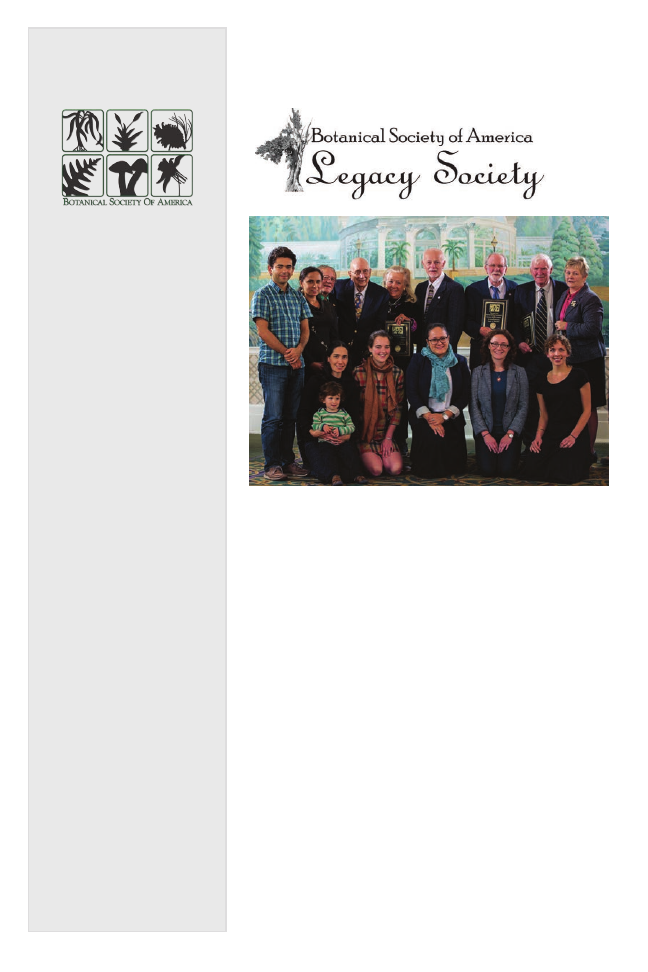
Plant Science Bulletin
Featured Image
The Botanical Society of
America is a membership
society whose mission is to:
promote botany, the field of
basic science dealing with the
study & inquiry into the form,
function, development, diversity,
reproduction, evolution, & uses
of plants & their interactions
within the biosphere.
ISSN 0032-0919
Published quarterly by
Botanical Society of America, Inc.
4475 Castleman Avenue
St. Louis, MO 63166-0299
Periodicals postage is paid at
St. Louis, MO & additional
mailing offices.
POSTMASTER:
Send address changes to:
Botanical Society of America
Business Office
P.O. Box 299
St. Louis, MO 63166-0299
bsa-manager@botany.org
The yearly subscription rate of
$15 is included in the membership
Address Editorial Matters (only) to:
Marshall D. Sundberg
Editor
Department of Biological Sciences
Emporia State University
1200 Commercial St.
Emporia, KS 66801-5057
Phone 620-341-5605
psb@botany.org
Plant Science
Bulletin
Winter 2013 Volume 59 Number 4
Legacy Society honorees and
Northeast region members celebrate at
the New York Botanical Garden.
Is the Legacy Society for you -
see page 160
Support your Society!
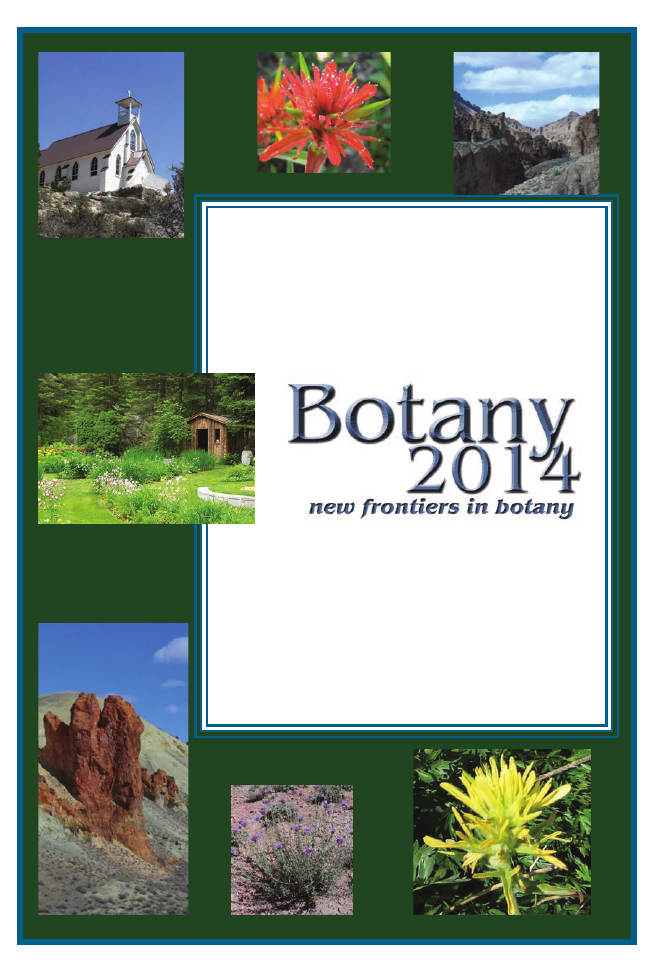
The Boise Center
July 26-30, 2014
www.2014.botanyconference.org
Make your plans now
for
Boise, Idaho...